Macroeconomic Performance of Australia and USA
VerifiedAdded on 2023/04/21
|20
|4878
|83
AI Summary
The paper analyzes the economic performance of Australia and USA from 1995 to 2015 based on key indicators such as GDP growth, inflation rate, unemployment rate, interest rate, net export, and exchange rate. It compares the macroeconomic policies undertaken by both countries and provides an economic outlook for Australia.
Contribute Materials
Your contribution can guide someone’s learning journey. Share your
documents today.
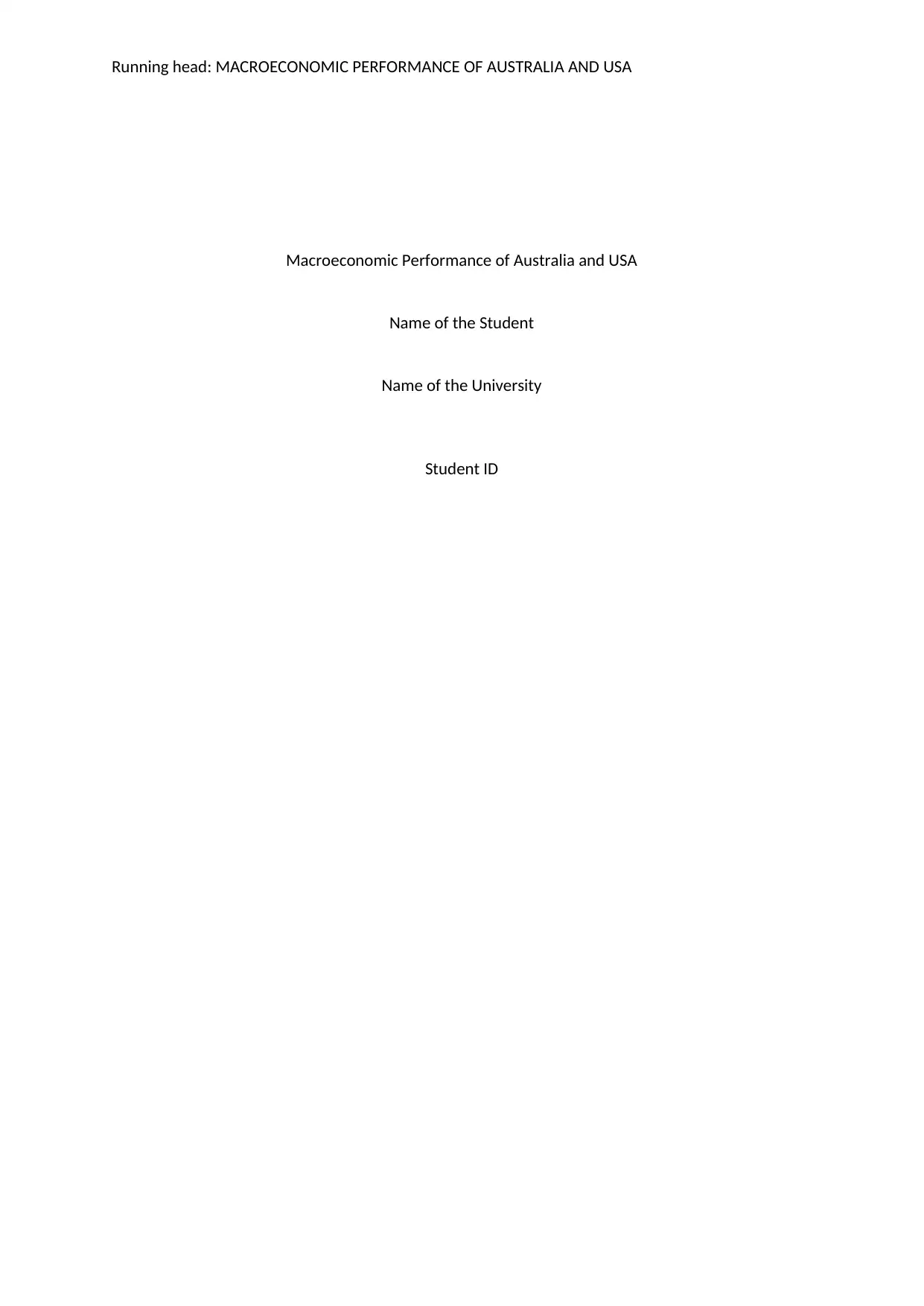
Running head: MACROECONOMIC PERFORMANCE OF AUSTRALIA AND USA
Macroeconomic Performance of Australia and USA
Name of the Student
Name of the University
Student ID
Macroeconomic Performance of Australia and USA
Name of the Student
Name of the University
Student ID
Secure Best Marks with AI Grader
Need help grading? Try our AI Grader for instant feedback on your assignments.
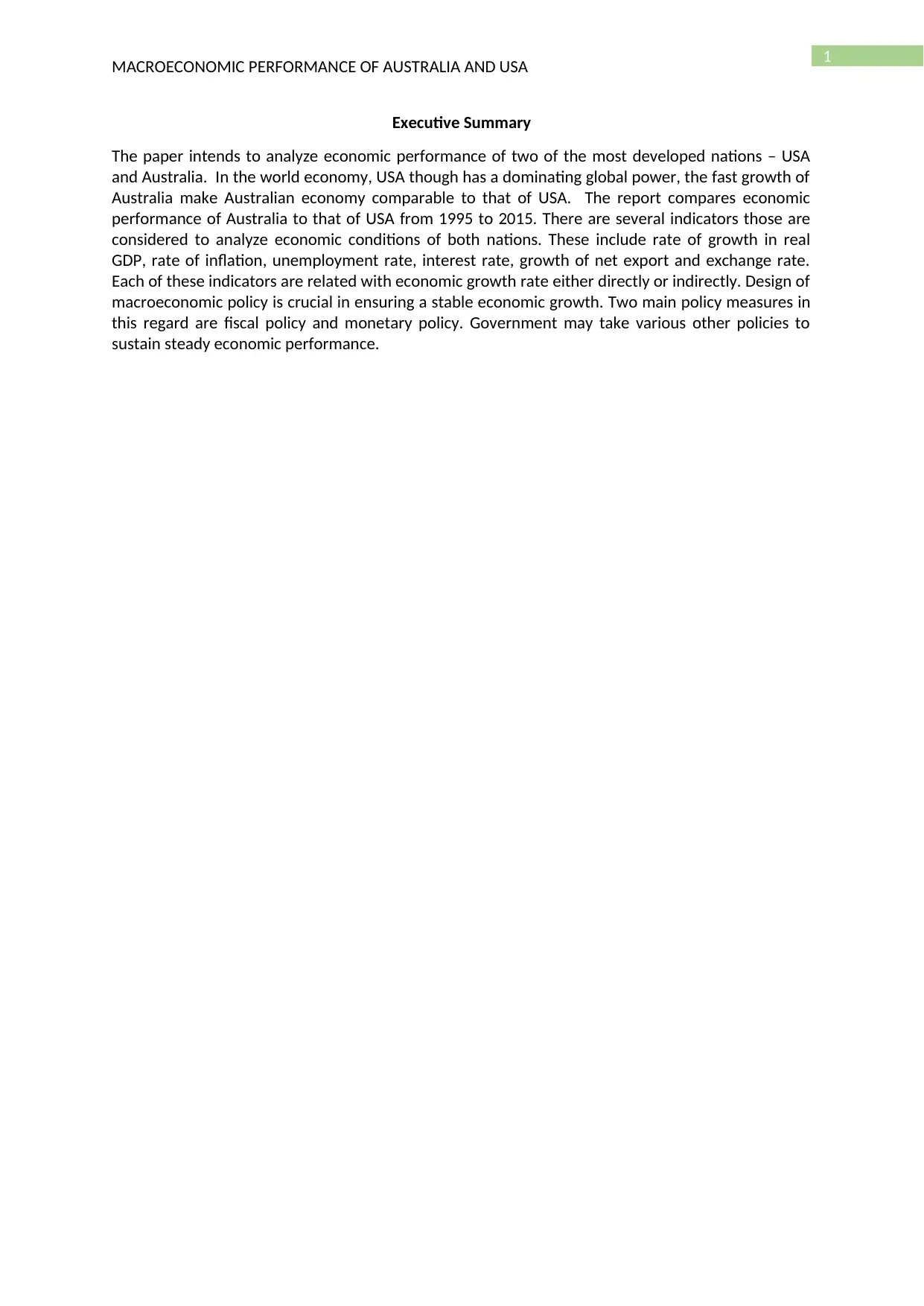
1
MACROECONOMIC PERFORMANCE OF AUSTRALIA AND USA
Executive Summary
The paper intends to analyze economic performance of two of the most developed nations – USA
and Australia. In the world economy, USA though has a dominating global power, the fast growth of
Australia make Australian economy comparable to that of USA. The report compares economic
performance of Australia to that of USA from 1995 to 2015. There are several indicators those are
considered to analyze economic conditions of both nations. These include rate of growth in real
GDP, rate of inflation, unemployment rate, interest rate, growth of net export and exchange rate.
Each of these indicators are related with economic growth rate either directly or indirectly. Design of
macroeconomic policy is crucial in ensuring a stable economic growth. Two main policy measures in
this regard are fiscal policy and monetary policy. Government may take various other policies to
sustain steady economic performance.
MACROECONOMIC PERFORMANCE OF AUSTRALIA AND USA
Executive Summary
The paper intends to analyze economic performance of two of the most developed nations – USA
and Australia. In the world economy, USA though has a dominating global power, the fast growth of
Australia make Australian economy comparable to that of USA. The report compares economic
performance of Australia to that of USA from 1995 to 2015. There are several indicators those are
considered to analyze economic conditions of both nations. These include rate of growth in real
GDP, rate of inflation, unemployment rate, interest rate, growth of net export and exchange rate.
Each of these indicators are related with economic growth rate either directly or indirectly. Design of
macroeconomic policy is crucial in ensuring a stable economic growth. Two main policy measures in
this regard are fiscal policy and monetary policy. Government may take various other policies to
sustain steady economic performance.
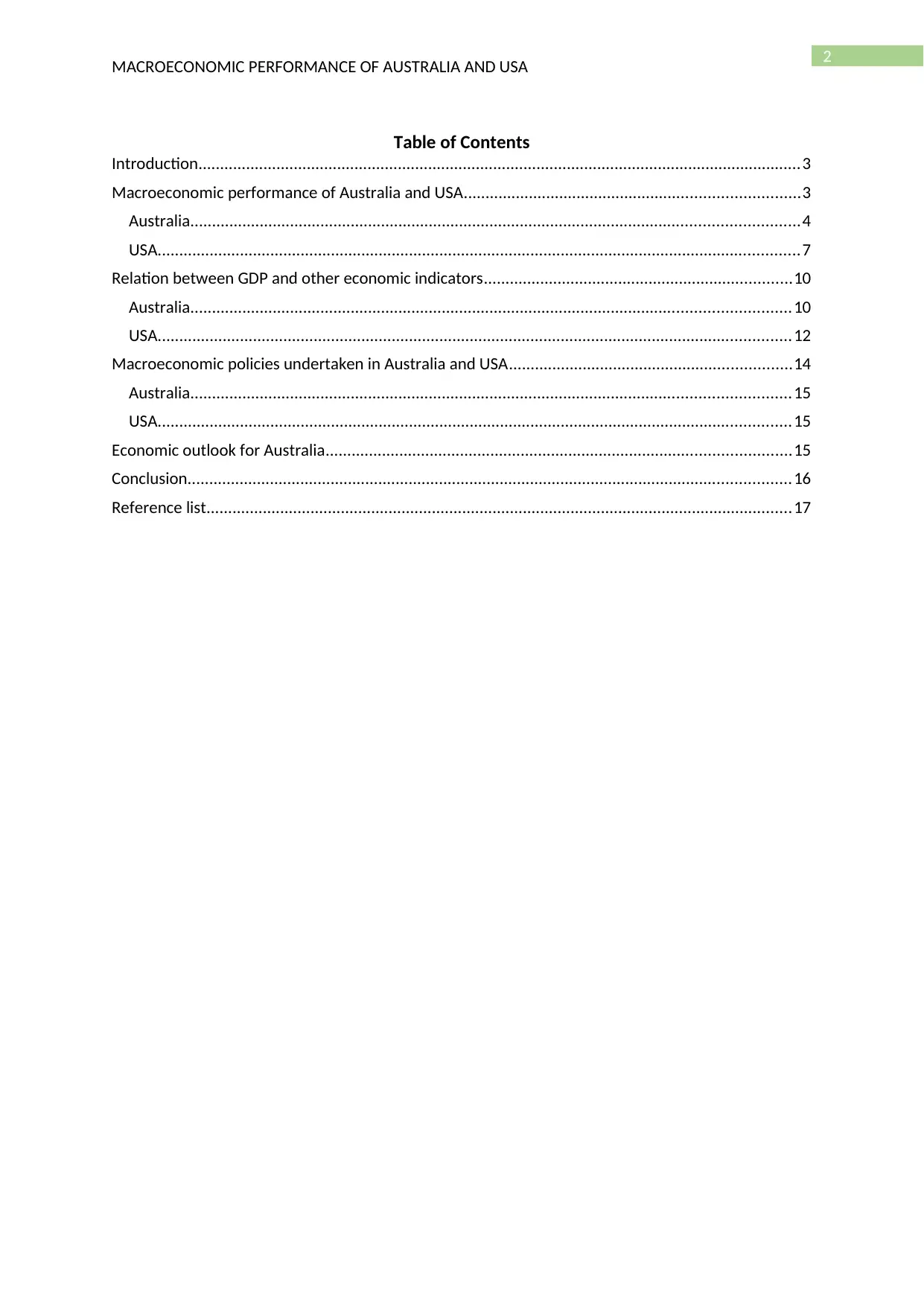
2
MACROECONOMIC PERFORMANCE OF AUSTRALIA AND USA
Table of Contents
Introduction...........................................................................................................................................3
Macroeconomic performance of Australia and USA.............................................................................3
Australia............................................................................................................................................4
USA....................................................................................................................................................7
Relation between GDP and other economic indicators.......................................................................10
Australia..........................................................................................................................................10
USA..................................................................................................................................................12
Macroeconomic policies undertaken in Australia and USA.................................................................14
Australia..........................................................................................................................................15
USA..................................................................................................................................................15
Economic outlook for Australia...........................................................................................................15
Conclusion...........................................................................................................................................16
Reference list.......................................................................................................................................17
MACROECONOMIC PERFORMANCE OF AUSTRALIA AND USA
Table of Contents
Introduction...........................................................................................................................................3
Macroeconomic performance of Australia and USA.............................................................................3
Australia............................................................................................................................................4
USA....................................................................................................................................................7
Relation between GDP and other economic indicators.......................................................................10
Australia..........................................................................................................................................10
USA..................................................................................................................................................12
Macroeconomic policies undertaken in Australia and USA.................................................................14
Australia..........................................................................................................................................15
USA..................................................................................................................................................15
Economic outlook for Australia...........................................................................................................15
Conclusion...........................................................................................................................................16
Reference list.......................................................................................................................................17
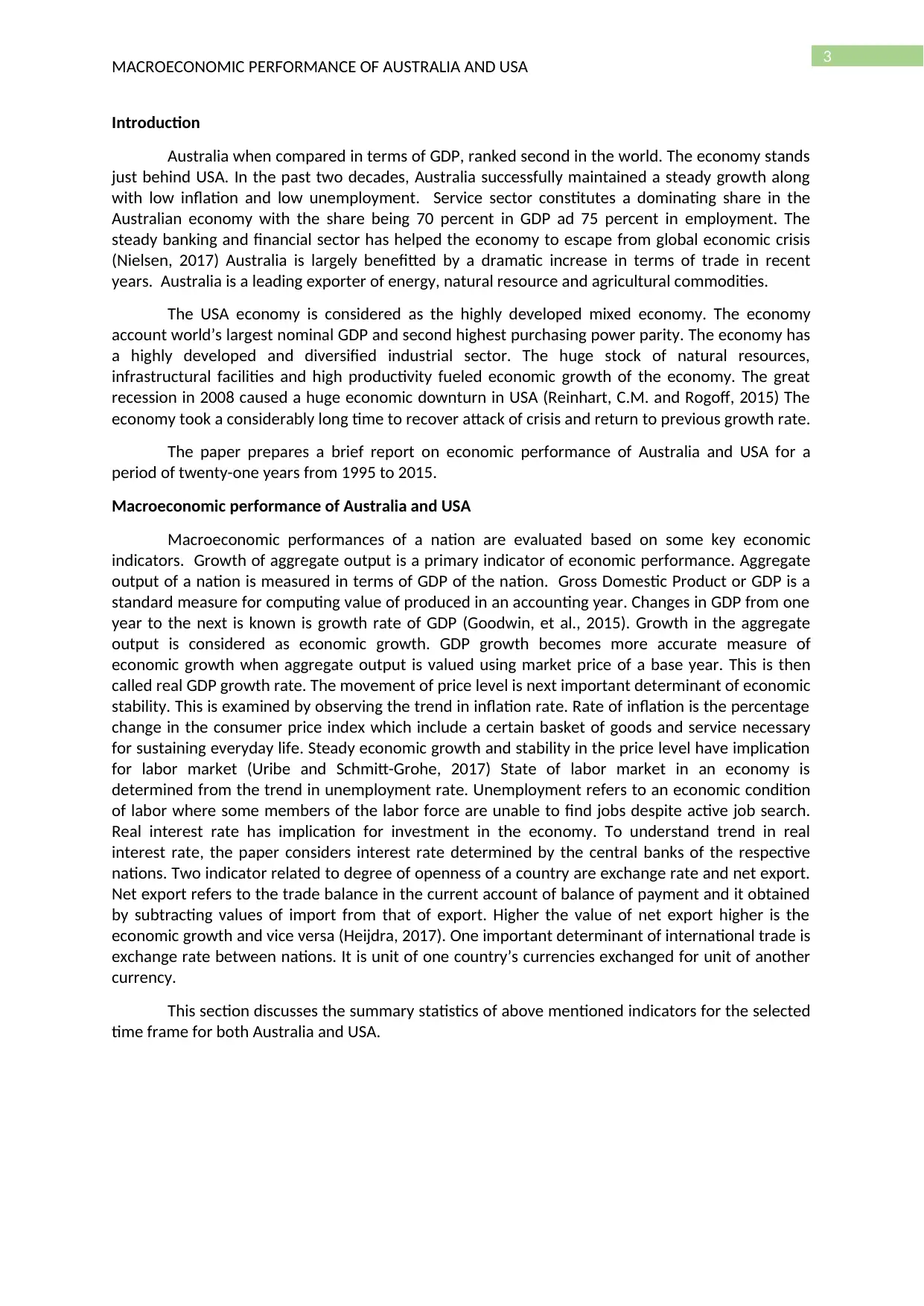
3
MACROECONOMIC PERFORMANCE OF AUSTRALIA AND USA
Introduction
Australia when compared in terms of GDP, ranked second in the world. The economy stands
just behind USA. In the past two decades, Australia successfully maintained a steady growth along
with low inflation and low unemployment. Service sector constitutes a dominating share in the
Australian economy with the share being 70 percent in GDP ad 75 percent in employment. The
steady banking and financial sector has helped the economy to escape from global economic crisis
(Nielsen, 2017) Australia is largely benefitted by a dramatic increase in terms of trade in recent
years. Australia is a leading exporter of energy, natural resource and agricultural commodities.
The USA economy is considered as the highly developed mixed economy. The economy
account world’s largest nominal GDP and second highest purchasing power parity. The economy has
a highly developed and diversified industrial sector. The huge stock of natural resources,
infrastructural facilities and high productivity fueled economic growth of the economy. The great
recession in 2008 caused a huge economic downturn in USA (Reinhart, C.M. and Rogoff, 2015) The
economy took a considerably long time to recover attack of crisis and return to previous growth rate.
The paper prepares a brief report on economic performance of Australia and USA for a
period of twenty-one years from 1995 to 2015.
Macroeconomic performance of Australia and USA
Macroeconomic performances of a nation are evaluated based on some key economic
indicators. Growth of aggregate output is a primary indicator of economic performance. Aggregate
output of a nation is measured in terms of GDP of the nation. Gross Domestic Product or GDP is a
standard measure for computing value of produced in an accounting year. Changes in GDP from one
year to the next is known is growth rate of GDP (Goodwin, et al., 2015). Growth in the aggregate
output is considered as economic growth. GDP growth becomes more accurate measure of
economic growth when aggregate output is valued using market price of a base year. This is then
called real GDP growth rate. The movement of price level is next important determinant of economic
stability. This is examined by observing the trend in inflation rate. Rate of inflation is the percentage
change in the consumer price index which include a certain basket of goods and service necessary
for sustaining everyday life. Steady economic growth and stability in the price level have implication
for labor market (Uribe and Schmitt-Grohe, 2017) State of labor market in an economy is
determined from the trend in unemployment rate. Unemployment refers to an economic condition
of labor where some members of the labor force are unable to find jobs despite active job search.
Real interest rate has implication for investment in the economy. To understand trend in real
interest rate, the paper considers interest rate determined by the central banks of the respective
nations. Two indicator related to degree of openness of a country are exchange rate and net export.
Net export refers to the trade balance in the current account of balance of payment and it obtained
by subtracting values of import from that of export. Higher the value of net export higher is the
economic growth and vice versa (Heijdra, 2017). One important determinant of international trade is
exchange rate between nations. It is unit of one country’s currencies exchanged for unit of another
currency.
This section discusses the summary statistics of above mentioned indicators for the selected
time frame for both Australia and USA.
MACROECONOMIC PERFORMANCE OF AUSTRALIA AND USA
Introduction
Australia when compared in terms of GDP, ranked second in the world. The economy stands
just behind USA. In the past two decades, Australia successfully maintained a steady growth along
with low inflation and low unemployment. Service sector constitutes a dominating share in the
Australian economy with the share being 70 percent in GDP ad 75 percent in employment. The
steady banking and financial sector has helped the economy to escape from global economic crisis
(Nielsen, 2017) Australia is largely benefitted by a dramatic increase in terms of trade in recent
years. Australia is a leading exporter of energy, natural resource and agricultural commodities.
The USA economy is considered as the highly developed mixed economy. The economy
account world’s largest nominal GDP and second highest purchasing power parity. The economy has
a highly developed and diversified industrial sector. The huge stock of natural resources,
infrastructural facilities and high productivity fueled economic growth of the economy. The great
recession in 2008 caused a huge economic downturn in USA (Reinhart, C.M. and Rogoff, 2015) The
economy took a considerably long time to recover attack of crisis and return to previous growth rate.
The paper prepares a brief report on economic performance of Australia and USA for a
period of twenty-one years from 1995 to 2015.
Macroeconomic performance of Australia and USA
Macroeconomic performances of a nation are evaluated based on some key economic
indicators. Growth of aggregate output is a primary indicator of economic performance. Aggregate
output of a nation is measured in terms of GDP of the nation. Gross Domestic Product or GDP is a
standard measure for computing value of produced in an accounting year. Changes in GDP from one
year to the next is known is growth rate of GDP (Goodwin, et al., 2015). Growth in the aggregate
output is considered as economic growth. GDP growth becomes more accurate measure of
economic growth when aggregate output is valued using market price of a base year. This is then
called real GDP growth rate. The movement of price level is next important determinant of economic
stability. This is examined by observing the trend in inflation rate. Rate of inflation is the percentage
change in the consumer price index which include a certain basket of goods and service necessary
for sustaining everyday life. Steady economic growth and stability in the price level have implication
for labor market (Uribe and Schmitt-Grohe, 2017) State of labor market in an economy is
determined from the trend in unemployment rate. Unemployment refers to an economic condition
of labor where some members of the labor force are unable to find jobs despite active job search.
Real interest rate has implication for investment in the economy. To understand trend in real
interest rate, the paper considers interest rate determined by the central banks of the respective
nations. Two indicator related to degree of openness of a country are exchange rate and net export.
Net export refers to the trade balance in the current account of balance of payment and it obtained
by subtracting values of import from that of export. Higher the value of net export higher is the
economic growth and vice versa (Heijdra, 2017). One important determinant of international trade is
exchange rate between nations. It is unit of one country’s currencies exchanged for unit of another
currency.
This section discusses the summary statistics of above mentioned indicators for the selected
time frame for both Australia and USA.
Secure Best Marks with AI Grader
Need help grading? Try our AI Grader for instant feedback on your assignments.
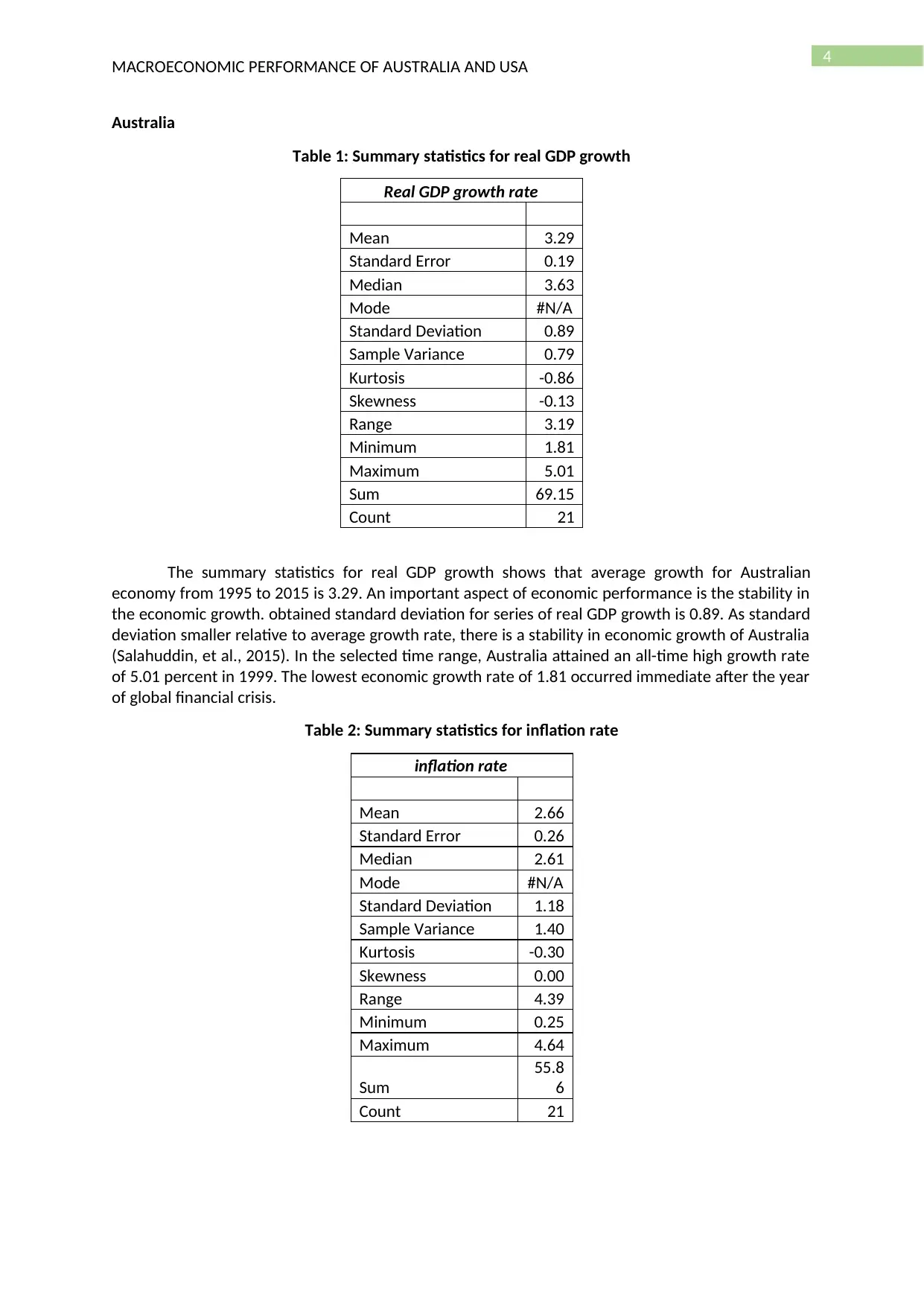
4
MACROECONOMIC PERFORMANCE OF AUSTRALIA AND USA
Australia
Table 1: Summary statistics for real GDP growth
Real GDP growth rate
Mean 3.29
Standard Error 0.19
Median 3.63
Mode #N/A
Standard Deviation 0.89
Sample Variance 0.79
Kurtosis -0.86
Skewness -0.13
Range 3.19
Minimum 1.81
Maximum 5.01
Sum 69.15
Count 21
The summary statistics for real GDP growth shows that average growth for Australian
economy from 1995 to 2015 is 3.29. An important aspect of economic performance is the stability in
the economic growth. obtained standard deviation for series of real GDP growth is 0.89. As standard
deviation smaller relative to average growth rate, there is a stability in economic growth of Australia
(Salahuddin, et al., 2015). In the selected time range, Australia attained an all-time high growth rate
of 5.01 percent in 1999. The lowest economic growth rate of 1.81 occurred immediate after the year
of global financial crisis.
Table 2: Summary statistics for inflation rate
inflation rate
Mean 2.66
Standard Error 0.26
Median 2.61
Mode #N/A
Standard Deviation 1.18
Sample Variance 1.40
Kurtosis -0.30
Skewness 0.00
Range 4.39
Minimum 0.25
Maximum 4.64
Sum
55.8
6
Count 21
MACROECONOMIC PERFORMANCE OF AUSTRALIA AND USA
Australia
Table 1: Summary statistics for real GDP growth
Real GDP growth rate
Mean 3.29
Standard Error 0.19
Median 3.63
Mode #N/A
Standard Deviation 0.89
Sample Variance 0.79
Kurtosis -0.86
Skewness -0.13
Range 3.19
Minimum 1.81
Maximum 5.01
Sum 69.15
Count 21
The summary statistics for real GDP growth shows that average growth for Australian
economy from 1995 to 2015 is 3.29. An important aspect of economic performance is the stability in
the economic growth. obtained standard deviation for series of real GDP growth is 0.89. As standard
deviation smaller relative to average growth rate, there is a stability in economic growth of Australia
(Salahuddin, et al., 2015). In the selected time range, Australia attained an all-time high growth rate
of 5.01 percent in 1999. The lowest economic growth rate of 1.81 occurred immediate after the year
of global financial crisis.
Table 2: Summary statistics for inflation rate
inflation rate
Mean 2.66
Standard Error 0.26
Median 2.61
Mode #N/A
Standard Deviation 1.18
Sample Variance 1.40
Kurtosis -0.30
Skewness 0.00
Range 4.39
Minimum 0.25
Maximum 4.64
Sum
55.8
6
Count 21
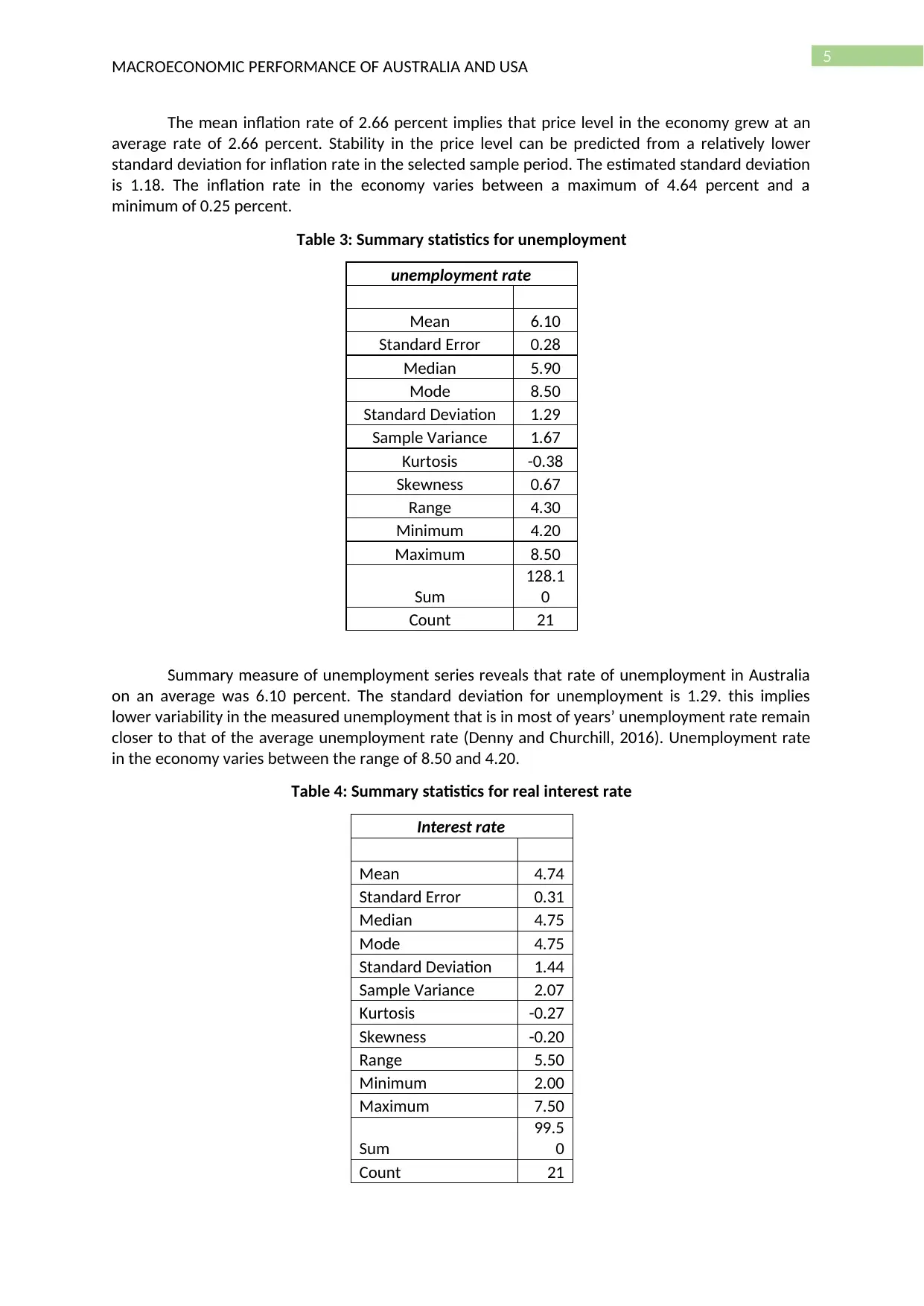
5
MACROECONOMIC PERFORMANCE OF AUSTRALIA AND USA
The mean inflation rate of 2.66 percent implies that price level in the economy grew at an
average rate of 2.66 percent. Stability in the price level can be predicted from a relatively lower
standard deviation for inflation rate in the selected sample period. The estimated standard deviation
is 1.18. The inflation rate in the economy varies between a maximum of 4.64 percent and a
minimum of 0.25 percent.
Table 3: Summary statistics for unemployment
unemployment rate
Mean 6.10
Standard Error 0.28
Median 5.90
Mode 8.50
Standard Deviation 1.29
Sample Variance 1.67
Kurtosis -0.38
Skewness 0.67
Range 4.30
Minimum 4.20
Maximum 8.50
Sum
128.1
0
Count 21
Summary measure of unemployment series reveals that rate of unemployment in Australia
on an average was 6.10 percent. The standard deviation for unemployment is 1.29. this implies
lower variability in the measured unemployment that is in most of years’ unemployment rate remain
closer to that of the average unemployment rate (Denny and Churchill, 2016). Unemployment rate
in the economy varies between the range of 8.50 and 4.20.
Table 4: Summary statistics for real interest rate
Interest rate
Mean 4.74
Standard Error 0.31
Median 4.75
Mode 4.75
Standard Deviation 1.44
Sample Variance 2.07
Kurtosis -0.27
Skewness -0.20
Range 5.50
Minimum 2.00
Maximum 7.50
Sum
99.5
0
Count 21
MACROECONOMIC PERFORMANCE OF AUSTRALIA AND USA
The mean inflation rate of 2.66 percent implies that price level in the economy grew at an
average rate of 2.66 percent. Stability in the price level can be predicted from a relatively lower
standard deviation for inflation rate in the selected sample period. The estimated standard deviation
is 1.18. The inflation rate in the economy varies between a maximum of 4.64 percent and a
minimum of 0.25 percent.
Table 3: Summary statistics for unemployment
unemployment rate
Mean 6.10
Standard Error 0.28
Median 5.90
Mode 8.50
Standard Deviation 1.29
Sample Variance 1.67
Kurtosis -0.38
Skewness 0.67
Range 4.30
Minimum 4.20
Maximum 8.50
Sum
128.1
0
Count 21
Summary measure of unemployment series reveals that rate of unemployment in Australia
on an average was 6.10 percent. The standard deviation for unemployment is 1.29. this implies
lower variability in the measured unemployment that is in most of years’ unemployment rate remain
closer to that of the average unemployment rate (Denny and Churchill, 2016). Unemployment rate
in the economy varies between the range of 8.50 and 4.20.
Table 4: Summary statistics for real interest rate
Interest rate
Mean 4.74
Standard Error 0.31
Median 4.75
Mode 4.75
Standard Deviation 1.44
Sample Variance 2.07
Kurtosis -0.27
Skewness -0.20
Range 5.50
Minimum 2.00
Maximum 7.50
Sum
99.5
0
Count 21
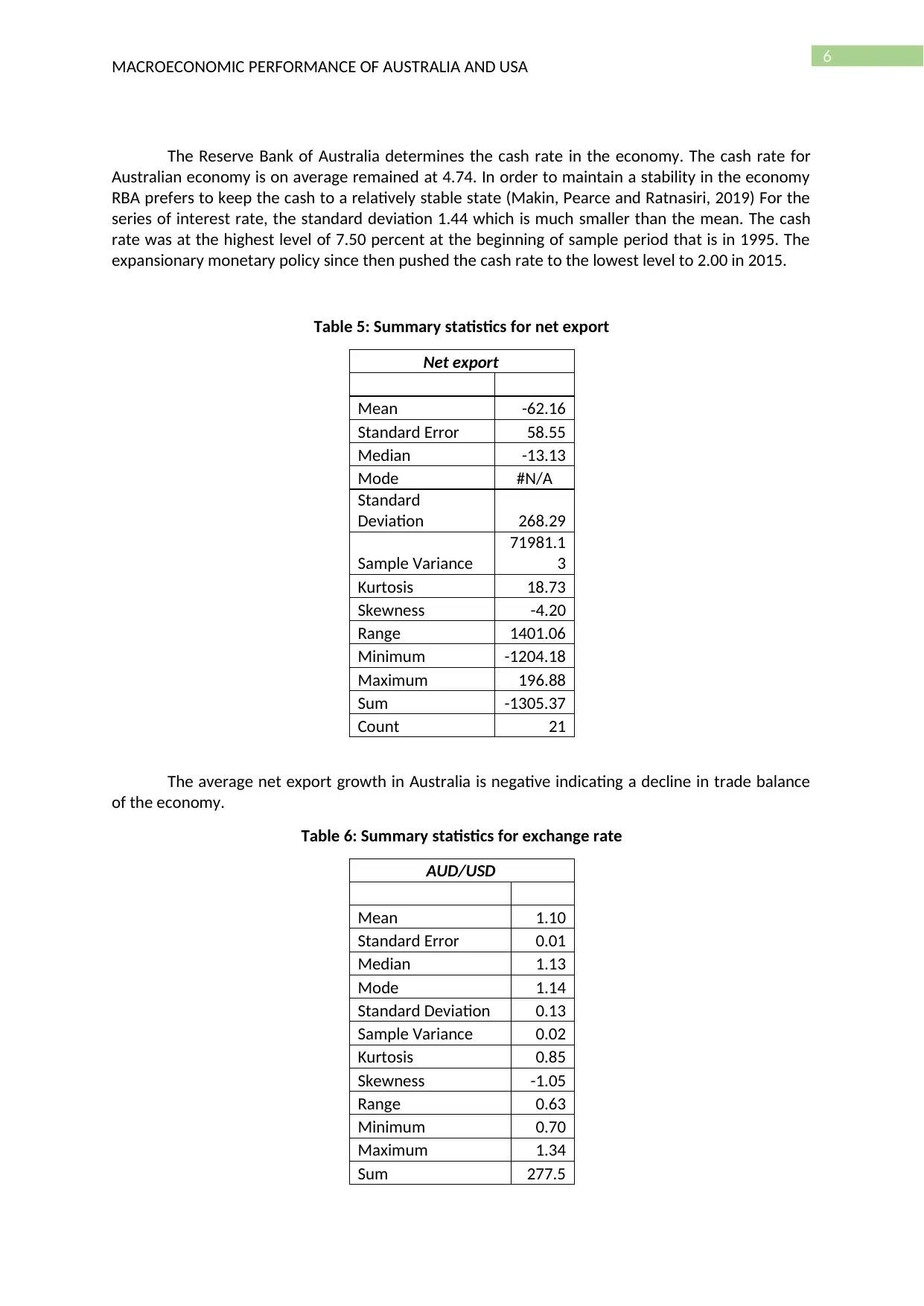
6
MACROECONOMIC PERFORMANCE OF AUSTRALIA AND USA
The Reserve Bank of Australia determines the cash rate in the economy. The cash rate for
Australian economy is on average remained at 4.74. In order to maintain a stability in the economy
RBA prefers to keep the cash to a relatively stable state (Makin, Pearce and Ratnasiri, 2019) For the
series of interest rate, the standard deviation 1.44 which is much smaller than the mean. The cash
rate was at the highest level of 7.50 percent at the beginning of sample period that is in 1995. The
expansionary monetary policy since then pushed the cash rate to the lowest level to 2.00 in 2015.
Table 5: Summary statistics for net export
Net export
Mean -62.16
Standard Error 58.55
Median -13.13
Mode #N/A
Standard
Deviation 268.29
Sample Variance
71981.1
3
Kurtosis 18.73
Skewness -4.20
Range 1401.06
Minimum -1204.18
Maximum 196.88
Sum -1305.37
Count 21
The average net export growth in Australia is negative indicating a decline in trade balance
of the economy.
Table 6: Summary statistics for exchange rate
AUD/USD
Mean 1.10
Standard Error 0.01
Median 1.13
Mode 1.14
Standard Deviation 0.13
Sample Variance 0.02
Kurtosis 0.85
Skewness -1.05
Range 0.63
Minimum 0.70
Maximum 1.34
Sum 277.5
MACROECONOMIC PERFORMANCE OF AUSTRALIA AND USA
The Reserve Bank of Australia determines the cash rate in the economy. The cash rate for
Australian economy is on average remained at 4.74. In order to maintain a stability in the economy
RBA prefers to keep the cash to a relatively stable state (Makin, Pearce and Ratnasiri, 2019) For the
series of interest rate, the standard deviation 1.44 which is much smaller than the mean. The cash
rate was at the highest level of 7.50 percent at the beginning of sample period that is in 1995. The
expansionary monetary policy since then pushed the cash rate to the lowest level to 2.00 in 2015.
Table 5: Summary statistics for net export
Net export
Mean -62.16
Standard Error 58.55
Median -13.13
Mode #N/A
Standard
Deviation 268.29
Sample Variance
71981.1
3
Kurtosis 18.73
Skewness -4.20
Range 1401.06
Minimum -1204.18
Maximum 196.88
Sum -1305.37
Count 21
The average net export growth in Australia is negative indicating a decline in trade balance
of the economy.
Table 6: Summary statistics for exchange rate
AUD/USD
Mean 1.10
Standard Error 0.01
Median 1.13
Mode 1.14
Standard Deviation 0.13
Sample Variance 0.02
Kurtosis 0.85
Skewness -1.05
Range 0.63
Minimum 0.70
Maximum 1.34
Sum 277.5
Paraphrase This Document
Need a fresh take? Get an instant paraphrase of this document with our AI Paraphraser

7
MACROECONOMIC PERFORMANCE OF AUSTRALIA AND USA
3
Count 252
From the series of monthly exchange rate, the average exchange rate is 1.10. This implies on
an average Australia exchanged 1.10 AUD against 1 USD. The lower standard deviation value of 0.13
implies the exchange rate remains relatively stable. The AUD/USD exchange rate is as high as 1.34
and as low as 0.70.
USA
Table 7: Summary statistics for real GDP growth
Real GDP growth rate
Mean 2.46
Standard Error 0.38
Median 2.67
Mode #N/A
Standard Deviation 1.73
Sample Variance 3.00
Kurtosis 3.14
Skewness -1.40
Range 7.46
Minimum -2.78
Maximum 4.69
Sum 51.57
Count 21
The descriptive statistics for real GDP growth shows that average growth for USA economy
from 1995 to 2015 is 2.46. The obtained standard deviation for series of real GDP growth is 1.73. As
standard deviation smaller relative to average growth rate, there is a stability in economic growth of
USA (Lindenberger, et al., 2017) In the selected time range, USA attained an all-time high growth
rate of 4.69 percent in 1999. The lowest economic growth rate of -2.78 occurred immediate after the
year of global financial crisis.
Table 8: Summary statistics for inflation rate
inflation rate
Mean 2.27
Standard Error 0.23
Median 2.34
Mode #N/A
Standard Deviation 1.05
Sample Variance 1.11
Kurtosis 0.93
Skewness -0.96
MACROECONOMIC PERFORMANCE OF AUSTRALIA AND USA
3
Count 252
From the series of monthly exchange rate, the average exchange rate is 1.10. This implies on
an average Australia exchanged 1.10 AUD against 1 USD. The lower standard deviation value of 0.13
implies the exchange rate remains relatively stable. The AUD/USD exchange rate is as high as 1.34
and as low as 0.70.
USA
Table 7: Summary statistics for real GDP growth
Real GDP growth rate
Mean 2.46
Standard Error 0.38
Median 2.67
Mode #N/A
Standard Deviation 1.73
Sample Variance 3.00
Kurtosis 3.14
Skewness -1.40
Range 7.46
Minimum -2.78
Maximum 4.69
Sum 51.57
Count 21
The descriptive statistics for real GDP growth shows that average growth for USA economy
from 1995 to 2015 is 2.46. The obtained standard deviation for series of real GDP growth is 1.73. As
standard deviation smaller relative to average growth rate, there is a stability in economic growth of
USA (Lindenberger, et al., 2017) In the selected time range, USA attained an all-time high growth
rate of 4.69 percent in 1999. The lowest economic growth rate of -2.78 occurred immediate after the
year of global financial crisis.
Table 8: Summary statistics for inflation rate
inflation rate
Mean 2.27
Standard Error 0.23
Median 2.34
Mode #N/A
Standard Deviation 1.05
Sample Variance 1.11
Kurtosis 0.93
Skewness -0.96
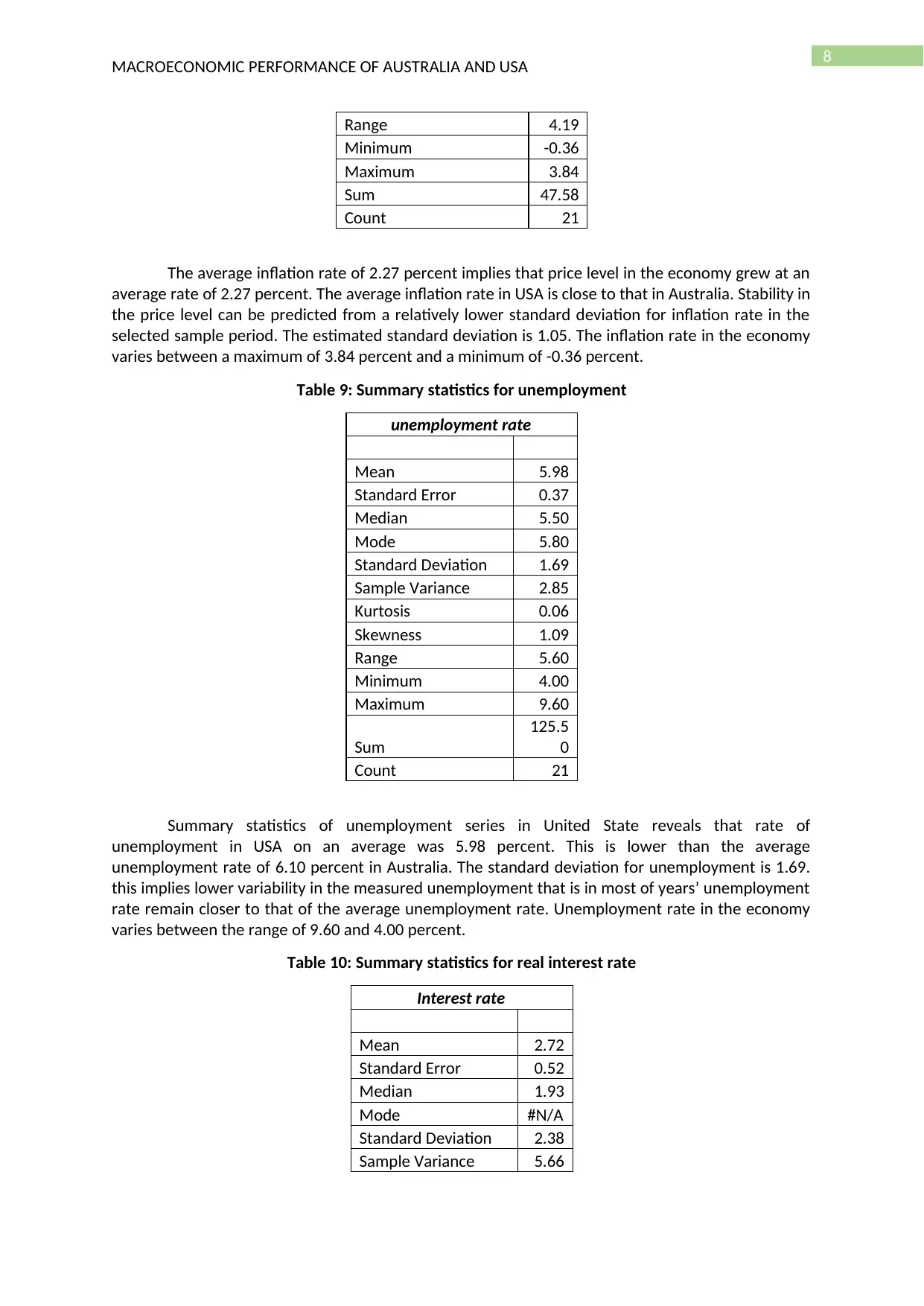
8
MACROECONOMIC PERFORMANCE OF AUSTRALIA AND USA
Range 4.19
Minimum -0.36
Maximum 3.84
Sum 47.58
Count 21
The average inflation rate of 2.27 percent implies that price level in the economy grew at an
average rate of 2.27 percent. The average inflation rate in USA is close to that in Australia. Stability in
the price level can be predicted from a relatively lower standard deviation for inflation rate in the
selected sample period. The estimated standard deviation is 1.05. The inflation rate in the economy
varies between a maximum of 3.84 percent and a minimum of -0.36 percent.
Table 9: Summary statistics for unemployment
unemployment rate
Mean 5.98
Standard Error 0.37
Median 5.50
Mode 5.80
Standard Deviation 1.69
Sample Variance 2.85
Kurtosis 0.06
Skewness 1.09
Range 5.60
Minimum 4.00
Maximum 9.60
Sum
125.5
0
Count 21
Summary statistics of unemployment series in United State reveals that rate of
unemployment in USA on an average was 5.98 percent. This is lower than the average
unemployment rate of 6.10 percent in Australia. The standard deviation for unemployment is 1.69.
this implies lower variability in the measured unemployment that is in most of years’ unemployment
rate remain closer to that of the average unemployment rate. Unemployment rate in the economy
varies between the range of 9.60 and 4.00 percent.
Table 10: Summary statistics for real interest rate
Interest rate
Mean 2.72
Standard Error 0.52
Median 1.93
Mode #N/A
Standard Deviation 2.38
Sample Variance 5.66
MACROECONOMIC PERFORMANCE OF AUSTRALIA AND USA
Range 4.19
Minimum -0.36
Maximum 3.84
Sum 47.58
Count 21
The average inflation rate of 2.27 percent implies that price level in the economy grew at an
average rate of 2.27 percent. The average inflation rate in USA is close to that in Australia. Stability in
the price level can be predicted from a relatively lower standard deviation for inflation rate in the
selected sample period. The estimated standard deviation is 1.05. The inflation rate in the economy
varies between a maximum of 3.84 percent and a minimum of -0.36 percent.
Table 9: Summary statistics for unemployment
unemployment rate
Mean 5.98
Standard Error 0.37
Median 5.50
Mode 5.80
Standard Deviation 1.69
Sample Variance 2.85
Kurtosis 0.06
Skewness 1.09
Range 5.60
Minimum 4.00
Maximum 9.60
Sum
125.5
0
Count 21
Summary statistics of unemployment series in United State reveals that rate of
unemployment in USA on an average was 5.98 percent. This is lower than the average
unemployment rate of 6.10 percent in Australia. The standard deviation for unemployment is 1.69.
this implies lower variability in the measured unemployment that is in most of years’ unemployment
rate remain closer to that of the average unemployment rate. Unemployment rate in the economy
varies between the range of 9.60 and 4.00 percent.
Table 10: Summary statistics for real interest rate
Interest rate
Mean 2.72
Standard Error 0.52
Median 1.93
Mode #N/A
Standard Deviation 2.38
Sample Variance 5.66

9
MACROECONOMIC PERFORMANCE OF AUSTRALIA AND USA
Kurtosis -1.82
Skewness 0.14
Range 6.15
Minimum 0.09
Maximum 6.24
Sum
57.2
2
Count 21
The Federal Reserve in USA determines the fund rate in the economy. The fund rate for USA
economy is on average remained at 2.72. In order to maintain a stability in the economy the Fed
prefers to keep the cash to a relatively stable state. For the series of interest rate, the standard
deviation 2.38 which is much smaller than the mean. The highest and lowest fund rate is obtained as
6.24 percent and 0.09 percent respectively.
Table 11: Summary statistics for net export
Net export
Mean 9.60
Standard Error 4.81
Median 6.47
Mode #N/A
Standard Deviation 22.03
Sample Variance
485.3
7
Kurtosis 2.88
Skewness 1.10
Range
102.9
5
Minimum -28.23
Maximum 74.72
Sum
201.5
5
Count 21
The mean growth rate for net export is 9.60 percent. The trade balance however is largely
variable for USA as implied by the large value of standard deviation for net export series.
Table 12: Summary statistics for exchange rate
USD/AUD
Mean 0.92
Standard Error 0.01
Median 0.89
Mode 0.87
Standard Deviation 0.13
Sample Variance 0.02
MACROECONOMIC PERFORMANCE OF AUSTRALIA AND USA
Kurtosis -1.82
Skewness 0.14
Range 6.15
Minimum 0.09
Maximum 6.24
Sum
57.2
2
Count 21
The Federal Reserve in USA determines the fund rate in the economy. The fund rate for USA
economy is on average remained at 2.72. In order to maintain a stability in the economy the Fed
prefers to keep the cash to a relatively stable state. For the series of interest rate, the standard
deviation 2.38 which is much smaller than the mean. The highest and lowest fund rate is obtained as
6.24 percent and 0.09 percent respectively.
Table 11: Summary statistics for net export
Net export
Mean 9.60
Standard Error 4.81
Median 6.47
Mode #N/A
Standard Deviation 22.03
Sample Variance
485.3
7
Kurtosis 2.88
Skewness 1.10
Range
102.9
5
Minimum -28.23
Maximum 74.72
Sum
201.5
5
Count 21
The mean growth rate for net export is 9.60 percent. The trade balance however is largely
variable for USA as implied by the large value of standard deviation for net export series.
Table 12: Summary statistics for exchange rate
USD/AUD
Mean 0.92
Standard Error 0.01
Median 0.89
Mode 0.87
Standard Deviation 0.13
Sample Variance 0.02
Secure Best Marks with AI Grader
Need help grading? Try our AI Grader for instant feedback on your assignments.
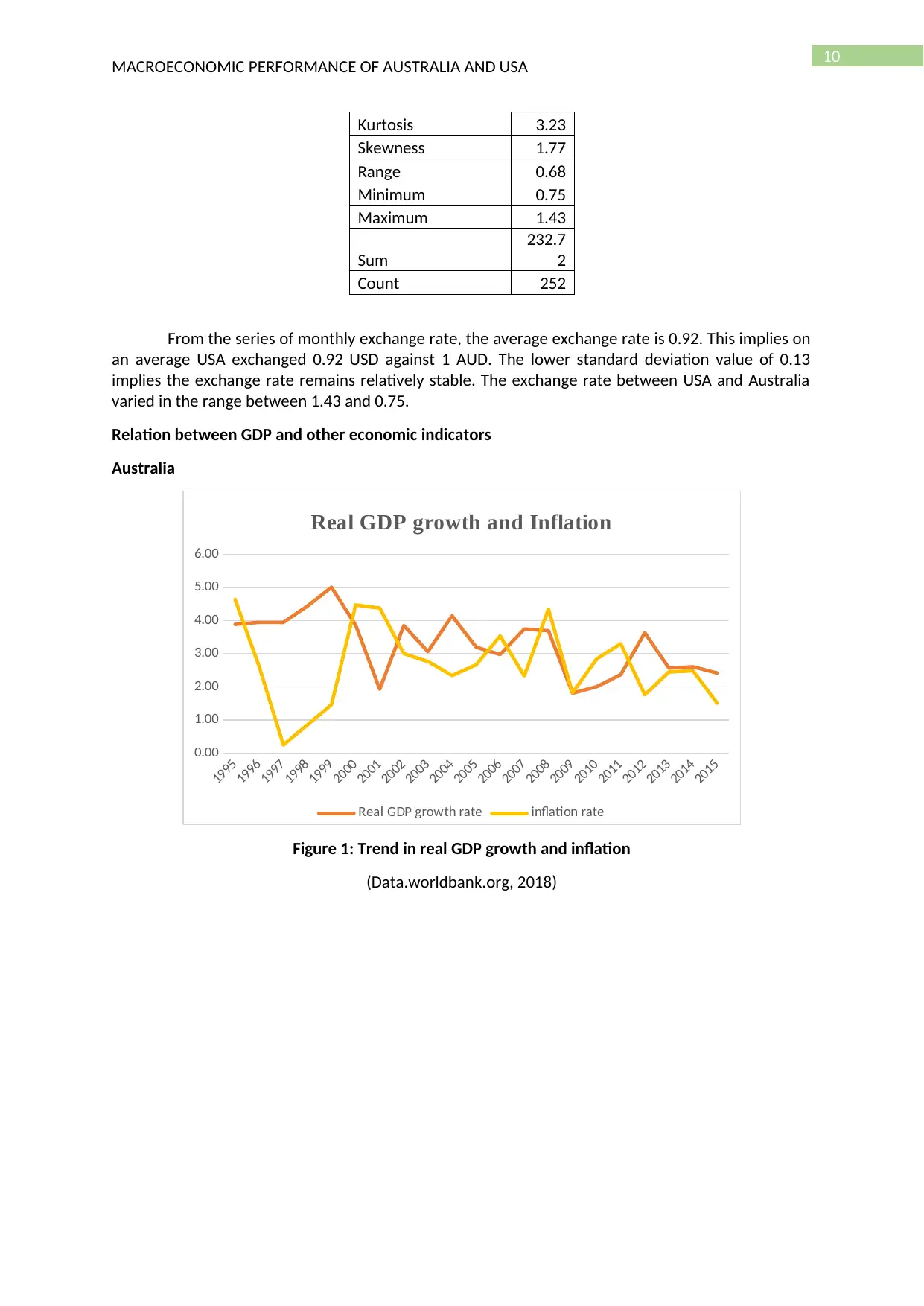
10
MACROECONOMIC PERFORMANCE OF AUSTRALIA AND USA
Kurtosis 3.23
Skewness 1.77
Range 0.68
Minimum 0.75
Maximum 1.43
Sum
232.7
2
Count 252
From the series of monthly exchange rate, the average exchange rate is 0.92. This implies on
an average USA exchanged 0.92 USD against 1 AUD. The lower standard deviation value of 0.13
implies the exchange rate remains relatively stable. The exchange rate between USA and Australia
varied in the range between 1.43 and 0.75.
Relation between GDP and other economic indicators
Australia
1995
1996
1997
1998
1999
2000
2001
2002
2003
2004
2005
2006
2007
2008
2009
2010
2011
2012
2013
2014
2015
0.00
1.00
2.00
3.00
4.00
5.00
6.00
Real GDP growth and Inflation
Real GDP growth rate inflation rate
Figure 1: Trend in real GDP growth and inflation
(Data.worldbank.org, 2018)
MACROECONOMIC PERFORMANCE OF AUSTRALIA AND USA
Kurtosis 3.23
Skewness 1.77
Range 0.68
Minimum 0.75
Maximum 1.43
Sum
232.7
2
Count 252
From the series of monthly exchange rate, the average exchange rate is 0.92. This implies on
an average USA exchanged 0.92 USD against 1 AUD. The lower standard deviation value of 0.13
implies the exchange rate remains relatively stable. The exchange rate between USA and Australia
varied in the range between 1.43 and 0.75.
Relation between GDP and other economic indicators
Australia
1995
1996
1997
1998
1999
2000
2001
2002
2003
2004
2005
2006
2007
2008
2009
2010
2011
2012
2013
2014
2015
0.00
1.00
2.00
3.00
4.00
5.00
6.00
Real GDP growth and Inflation
Real GDP growth rate inflation rate
Figure 1: Trend in real GDP growth and inflation
(Data.worldbank.org, 2018)
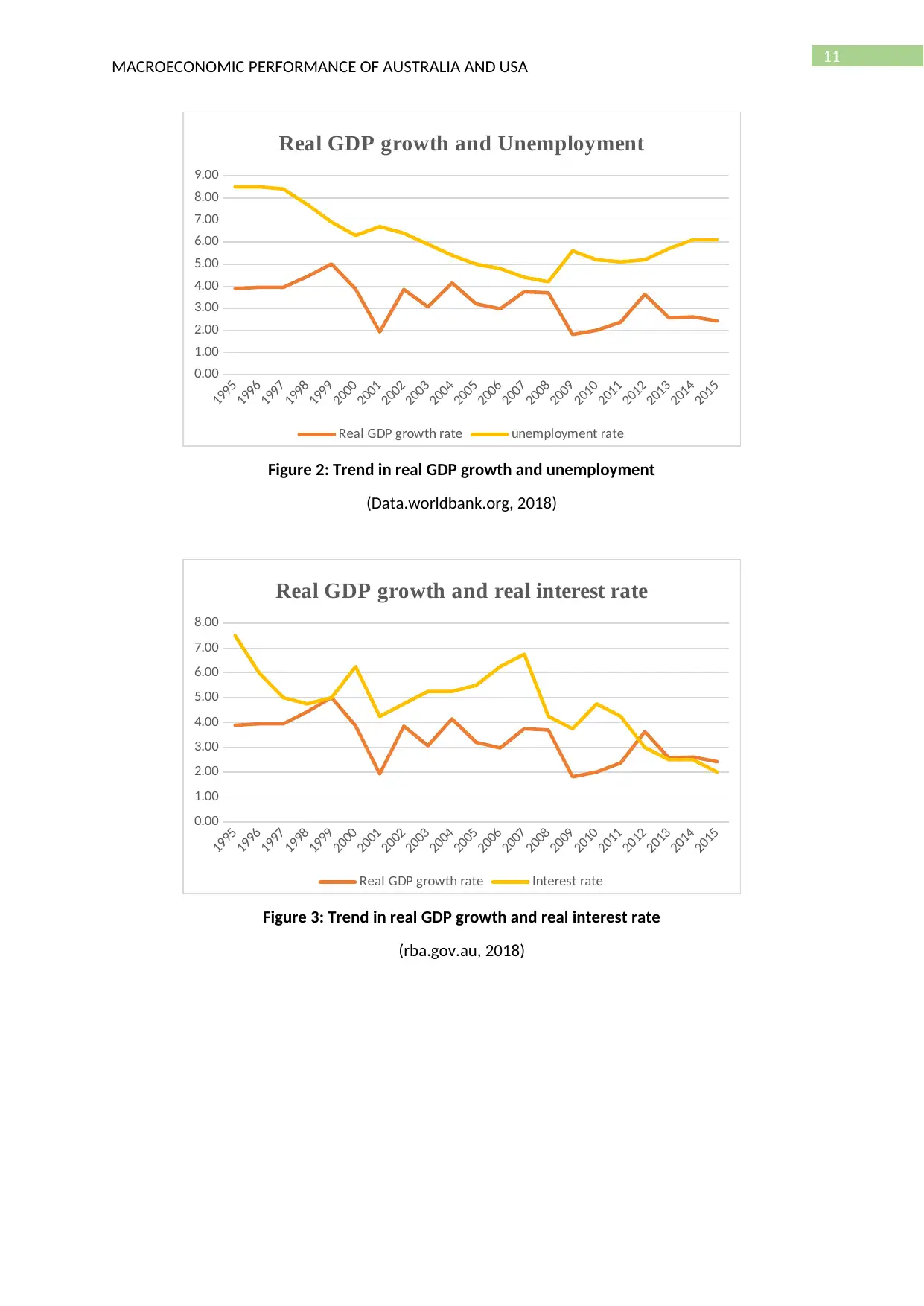
11
MACROECONOMIC PERFORMANCE OF AUSTRALIA AND USA
1995
1996
1997
1998
1999
2000
2001
2002
2003
2004
2005
2006
2007
2008
2009
2010
2011
2012
2013
2014
2015
0.00
1.00
2.00
3.00
4.00
5.00
6.00
7.00
8.00
9.00
Real GDP growth and Unemployment
Real GDP growth rate unemployment rate
Figure 2: Trend in real GDP growth and unemployment
(Data.worldbank.org, 2018)
1995
1996
1997
1998
1999
2000
2001
2002
2003
2004
2005
2006
2007
2008
2009
2010
2011
2012
2013
2014
2015
0.00
1.00
2.00
3.00
4.00
5.00
6.00
7.00
8.00
Real GDP growth and real interest rate
Real GDP growth rate Interest rate
Figure 3: Trend in real GDP growth and real interest rate
(rba.gov.au, 2018)
MACROECONOMIC PERFORMANCE OF AUSTRALIA AND USA
1995
1996
1997
1998
1999
2000
2001
2002
2003
2004
2005
2006
2007
2008
2009
2010
2011
2012
2013
2014
2015
0.00
1.00
2.00
3.00
4.00
5.00
6.00
7.00
8.00
9.00
Real GDP growth and Unemployment
Real GDP growth rate unemployment rate
Figure 2: Trend in real GDP growth and unemployment
(Data.worldbank.org, 2018)
1995
1996
1997
1998
1999
2000
2001
2002
2003
2004
2005
2006
2007
2008
2009
2010
2011
2012
2013
2014
2015
0.00
1.00
2.00
3.00
4.00
5.00
6.00
7.00
8.00
Real GDP growth and real interest rate
Real GDP growth rate Interest rate
Figure 3: Trend in real GDP growth and real interest rate
(rba.gov.au, 2018)
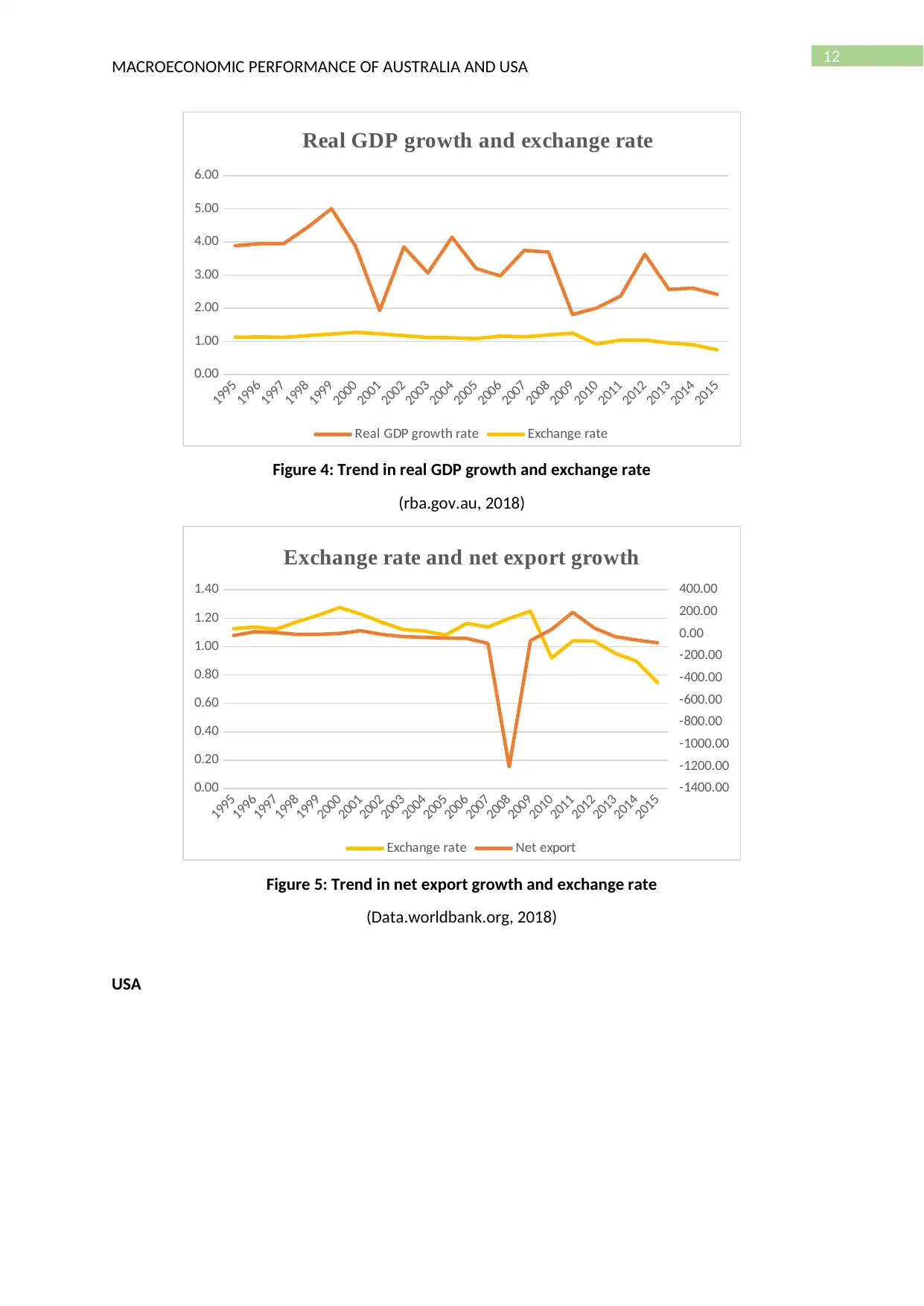
12
MACROECONOMIC PERFORMANCE OF AUSTRALIA AND USA
1995
1996
1997
1998
1999
2000
2001
2002
2003
2004
2005
2006
2007
2008
2009
2010
2011
2012
2013
2014
2015
0.00
1.00
2.00
3.00
4.00
5.00
6.00
Real GDP growth and exchange rate
Real GDP growth rate Exchange rate
Figure 4: Trend in real GDP growth and exchange rate
(rba.gov.au, 2018)
1995
1996
1997
1998
1999
2000
2001
2002
2003
2004
2005
2006
2007
2008
2009
2010
2011
2012
2013
2014
2015
0.00
0.20
0.40
0.60
0.80
1.00
1.20
1.40
-1400.00
-1200.00
-1000.00
-800.00
-600.00
-400.00
-200.00
0.00
200.00
400.00
Exchange rate and net export growth
Exchange rate Net export
Figure 5: Trend in net export growth and exchange rate
(Data.worldbank.org, 2018)
USA
MACROECONOMIC PERFORMANCE OF AUSTRALIA AND USA
1995
1996
1997
1998
1999
2000
2001
2002
2003
2004
2005
2006
2007
2008
2009
2010
2011
2012
2013
2014
2015
0.00
1.00
2.00
3.00
4.00
5.00
6.00
Real GDP growth and exchange rate
Real GDP growth rate Exchange rate
Figure 4: Trend in real GDP growth and exchange rate
(rba.gov.au, 2018)
1995
1996
1997
1998
1999
2000
2001
2002
2003
2004
2005
2006
2007
2008
2009
2010
2011
2012
2013
2014
2015
0.00
0.20
0.40
0.60
0.80
1.00
1.20
1.40
-1400.00
-1200.00
-1000.00
-800.00
-600.00
-400.00
-200.00
0.00
200.00
400.00
Exchange rate and net export growth
Exchange rate Net export
Figure 5: Trend in net export growth and exchange rate
(Data.worldbank.org, 2018)
USA
Paraphrase This Document
Need a fresh take? Get an instant paraphrase of this document with our AI Paraphraser
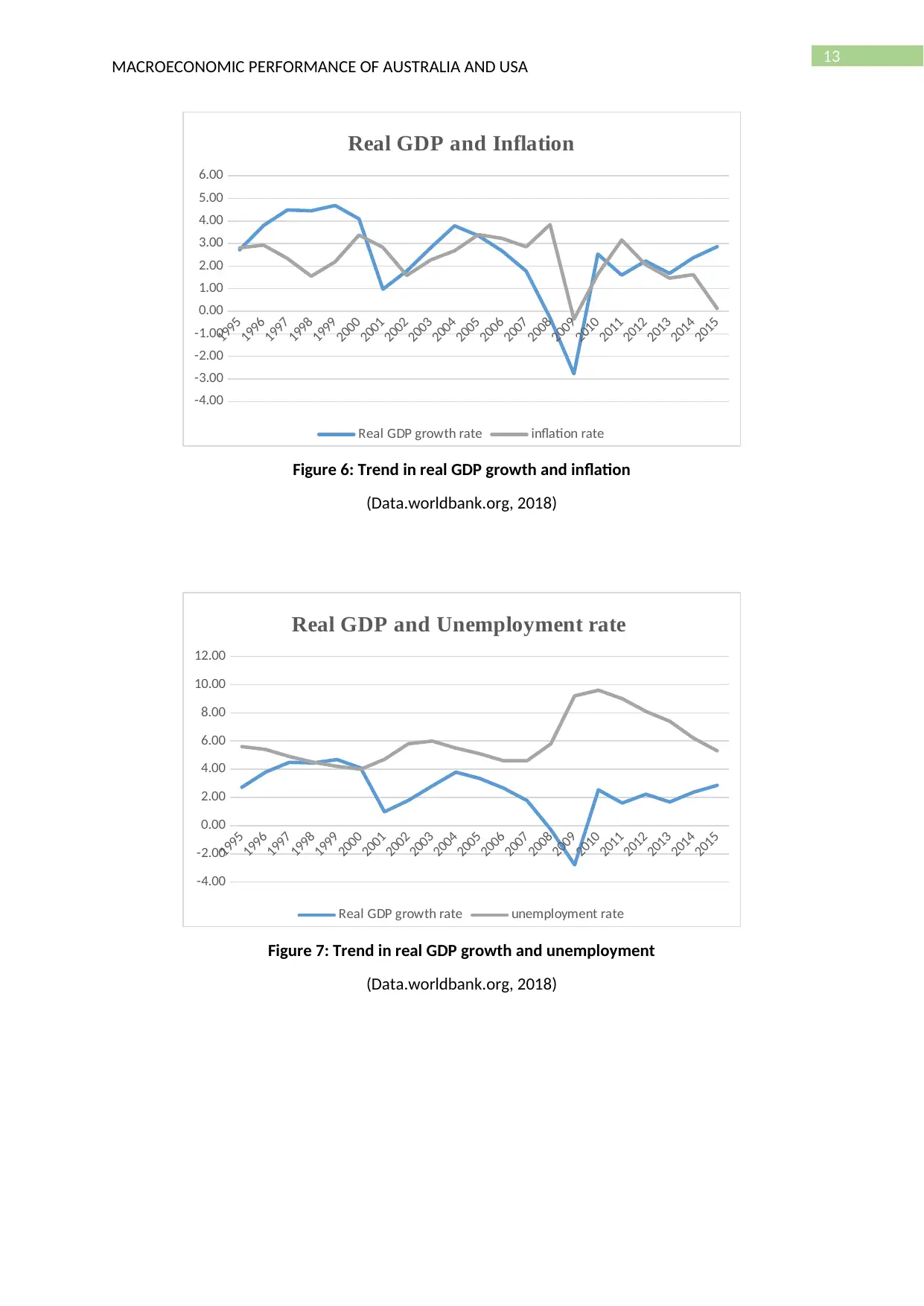
13
MACROECONOMIC PERFORMANCE OF AUSTRALIA AND USA
1995
1996
1997
1998
1999
2000
2001
2002
2003
2004
2005
2006
2007
2008
2009
2010
2011
2012
2013
2014
2015
-4.00
-3.00
-2.00
-1.00
0.00
1.00
2.00
3.00
4.00
5.00
6.00
Real GDP and Inflation
Real GDP growth rate inflation rate
Figure 6: Trend in real GDP growth and inflation
(Data.worldbank.org, 2018)
1995
1996
1997
1998
1999
2000
2001
2002
2003
2004
2005
2006
2007
2008
2009
2010
2011
2012
2013
2014
2015
-4.00
-2.00
0.00
2.00
4.00
6.00
8.00
10.00
12.00
Real GDP and Unemployment rate
Real GDP growth rate unemployment rate
Figure 7: Trend in real GDP growth and unemployment
(Data.worldbank.org, 2018)
MACROECONOMIC PERFORMANCE OF AUSTRALIA AND USA
1995
1996
1997
1998
1999
2000
2001
2002
2003
2004
2005
2006
2007
2008
2009
2010
2011
2012
2013
2014
2015
-4.00
-3.00
-2.00
-1.00
0.00
1.00
2.00
3.00
4.00
5.00
6.00
Real GDP and Inflation
Real GDP growth rate inflation rate
Figure 6: Trend in real GDP growth and inflation
(Data.worldbank.org, 2018)
1995
1996
1997
1998
1999
2000
2001
2002
2003
2004
2005
2006
2007
2008
2009
2010
2011
2012
2013
2014
2015
-4.00
-2.00
0.00
2.00
4.00
6.00
8.00
10.00
12.00
Real GDP and Unemployment rate
Real GDP growth rate unemployment rate
Figure 7: Trend in real GDP growth and unemployment
(Data.worldbank.org, 2018)
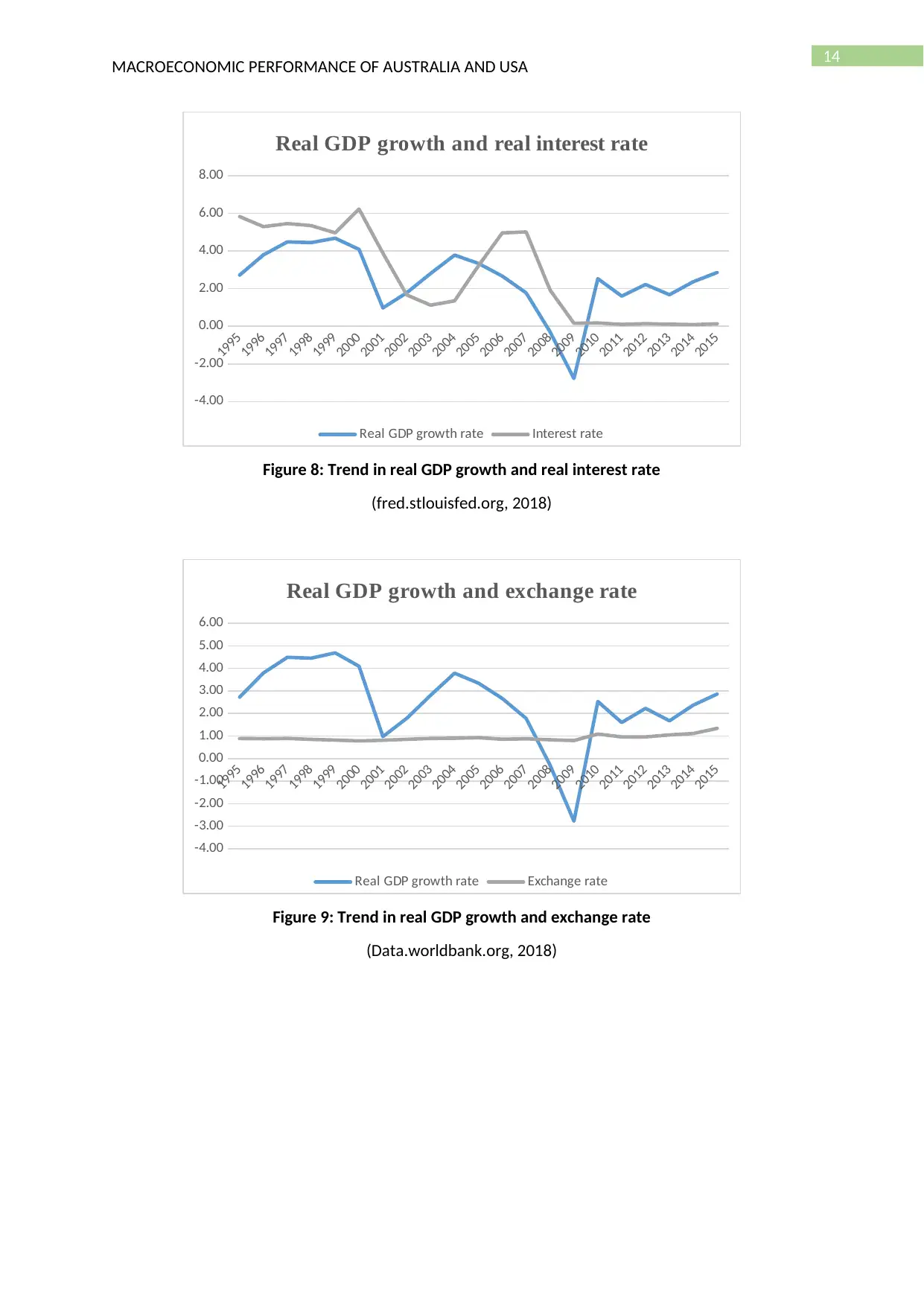
14
MACROECONOMIC PERFORMANCE OF AUSTRALIA AND USA
1995
1996
1997
1998
1999
2000
2001
2002
2003
2004
2005
2006
2007
2008
2009
2010
2011
2012
2013
2014
2015
-4.00
-2.00
0.00
2.00
4.00
6.00
8.00
Real GDP growth and real interest rate
Real GDP growth rate Interest rate
Figure 8: Trend in real GDP growth and real interest rate
(fred.stlouisfed.org, 2018)
1995
1996
1997
1998
1999
2000
2001
2002
2003
2004
2005
2006
2007
2008
2009
2010
2011
2012
2013
2014
2015
-4.00
-3.00
-2.00
-1.00
0.00
1.00
2.00
3.00
4.00
5.00
6.00
Real GDP growth and exchange rate
Real GDP growth rate Exchange rate
Figure 9: Trend in real GDP growth and exchange rate
(Data.worldbank.org, 2018)
MACROECONOMIC PERFORMANCE OF AUSTRALIA AND USA
1995
1996
1997
1998
1999
2000
2001
2002
2003
2004
2005
2006
2007
2008
2009
2010
2011
2012
2013
2014
2015
-4.00
-2.00
0.00
2.00
4.00
6.00
8.00
Real GDP growth and real interest rate
Real GDP growth rate Interest rate
Figure 8: Trend in real GDP growth and real interest rate
(fred.stlouisfed.org, 2018)
1995
1996
1997
1998
1999
2000
2001
2002
2003
2004
2005
2006
2007
2008
2009
2010
2011
2012
2013
2014
2015
-4.00
-3.00
-2.00
-1.00
0.00
1.00
2.00
3.00
4.00
5.00
6.00
Real GDP growth and exchange rate
Real GDP growth rate Exchange rate
Figure 9: Trend in real GDP growth and exchange rate
(Data.worldbank.org, 2018)

15
MACROECONOMIC PERFORMANCE OF AUSTRALIA AND USA
1995
1996
1997
1998
1999
2000
2001
2002
2003
2004
2005
2006
2007
2008
2009
2010
2011
2012
2013
2014
2015
0.00
0.20
0.40
0.60
0.80
1.00
1.20
1.40
1.60
-40.00
-20.00
0.00
20.00
40.00
60.00
80.00
100.00
Exchange rate and net export growth
Exchange rate Net export
Figure 10: Trend in net export growth and exchange rate
(Data.worldbank.org, 2018)
Macroeconomic policies undertaken in Australia and USA
Steady economic performance of a nation is subject to suitable design of government
policies to achieve certain macroeconomic goals. Government aims to attain long term stable growth
along with a stable price level and unemployment (Johnson, 2017) Government uses fiscal policy or
monetary policy or a combination of both to accomplish certain objectives.
MACROECONOMIC PERFORMANCE OF AUSTRALIA AND USA
1995
1996
1997
1998
1999
2000
2001
2002
2003
2004
2005
2006
2007
2008
2009
2010
2011
2012
2013
2014
2015
0.00
0.20
0.40
0.60
0.80
1.00
1.20
1.40
1.60
-40.00
-20.00
0.00
20.00
40.00
60.00
80.00
100.00
Exchange rate and net export growth
Exchange rate Net export
Figure 10: Trend in net export growth and exchange rate
(Data.worldbank.org, 2018)
Macroeconomic policies undertaken in Australia and USA
Steady economic performance of a nation is subject to suitable design of government
policies to achieve certain macroeconomic goals. Government aims to attain long term stable growth
along with a stable price level and unemployment (Johnson, 2017) Government uses fiscal policy or
monetary policy or a combination of both to accomplish certain objectives.
Secure Best Marks with AI Grader
Need help grading? Try our AI Grader for instant feedback on your assignments.
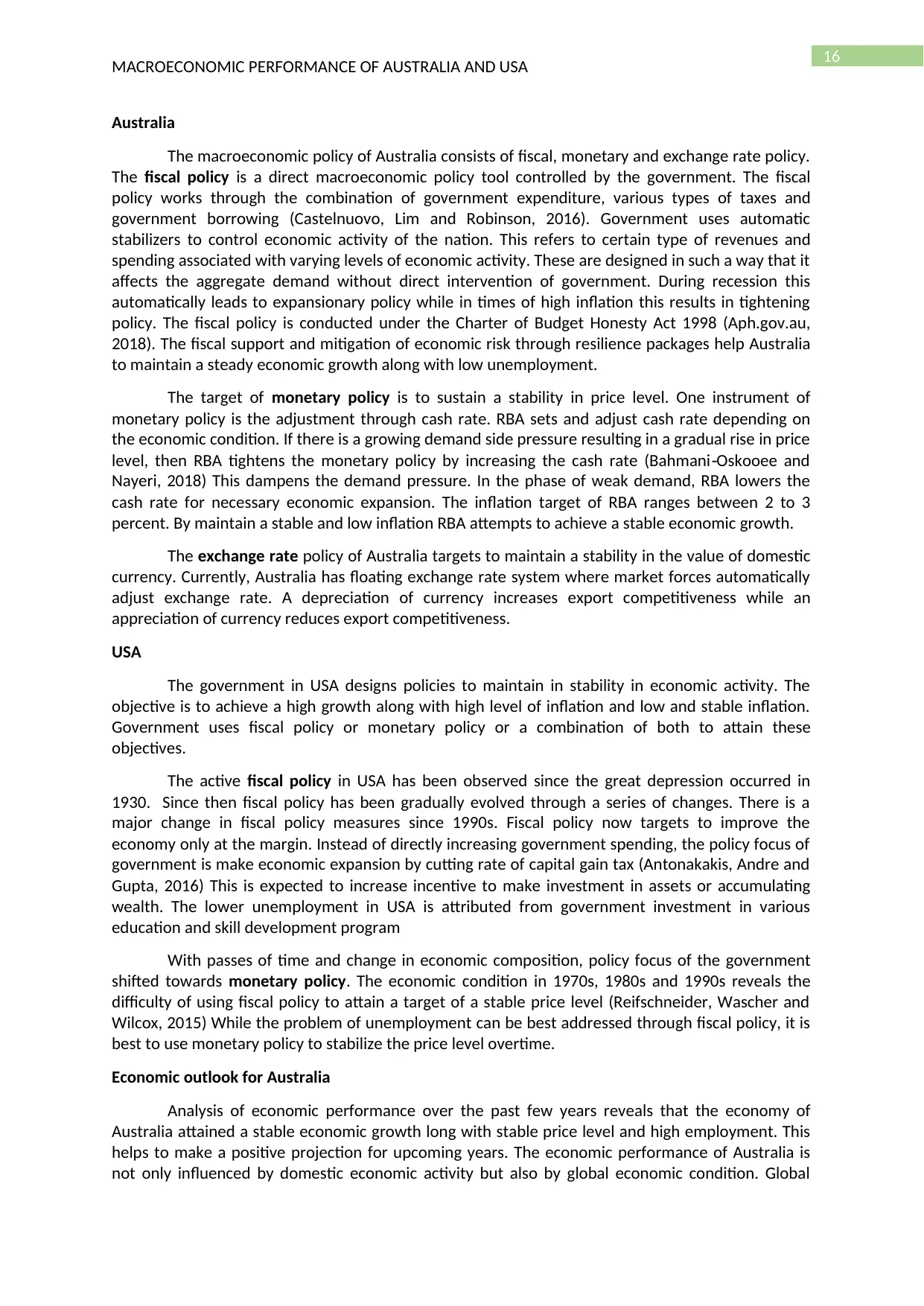
16
MACROECONOMIC PERFORMANCE OF AUSTRALIA AND USA
Australia
The macroeconomic policy of Australia consists of fiscal, monetary and exchange rate policy.
The fiscal policy is a direct macroeconomic policy tool controlled by the government. The fiscal
policy works through the combination of government expenditure, various types of taxes and
government borrowing (Castelnuovo, Lim and Robinson, 2016). Government uses automatic
stabilizers to control economic activity of the nation. This refers to certain type of revenues and
spending associated with varying levels of economic activity. These are designed in such a way that it
affects the aggregate demand without direct intervention of government. During recession this
automatically leads to expansionary policy while in times of high inflation this results in tightening
policy. The fiscal policy is conducted under the Charter of Budget Honesty Act 1998 (Aph.gov.au,
2018). The fiscal support and mitigation of economic risk through resilience packages help Australia
to maintain a steady economic growth along with low unemployment.
The target of monetary policy is to sustain a stability in price level. One instrument of
monetary policy is the adjustment through cash rate. RBA sets and adjust cash rate depending on
the economic condition. If there is a growing demand side pressure resulting in a gradual rise in price
level, then RBA tightens the monetary policy by increasing the cash rate (Bahmani Oskooee and‐
Nayeri, 2018) This dampens the demand pressure. In the phase of weak demand, RBA lowers the
cash rate for necessary economic expansion. The inflation target of RBA ranges between 2 to 3
percent. By maintain a stable and low inflation RBA attempts to achieve a stable economic growth.
The exchange rate policy of Australia targets to maintain a stability in the value of domestic
currency. Currently, Australia has floating exchange rate system where market forces automatically
adjust exchange rate. A depreciation of currency increases export competitiveness while an
appreciation of currency reduces export competitiveness.
USA
The government in USA designs policies to maintain in stability in economic activity. The
objective is to achieve a high growth along with high level of inflation and low and stable inflation.
Government uses fiscal policy or monetary policy or a combination of both to attain these
objectives.
The active fiscal policy in USA has been observed since the great depression occurred in
1930. Since then fiscal policy has been gradually evolved through a series of changes. There is a
major change in fiscal policy measures since 1990s. Fiscal policy now targets to improve the
economy only at the margin. Instead of directly increasing government spending, the policy focus of
government is make economic expansion by cutting rate of capital gain tax (Antonakakis, Andre and
Gupta, 2016) This is expected to increase incentive to make investment in assets or accumulating
wealth. The lower unemployment in USA is attributed from government investment in various
education and skill development program
With passes of time and change in economic composition, policy focus of the government
shifted towards monetary policy. The economic condition in 1970s, 1980s and 1990s reveals the
difficulty of using fiscal policy to attain a target of a stable price level (Reifschneider, Wascher and
Wilcox, 2015) While the problem of unemployment can be best addressed through fiscal policy, it is
best to use monetary policy to stabilize the price level overtime.
Economic outlook for Australia
Analysis of economic performance over the past few years reveals that the economy of
Australia attained a stable economic growth long with stable price level and high employment. This
helps to make a positive projection for upcoming years. The economic performance of Australia is
not only influenced by domestic economic activity but also by global economic condition. Global
MACROECONOMIC PERFORMANCE OF AUSTRALIA AND USA
Australia
The macroeconomic policy of Australia consists of fiscal, monetary and exchange rate policy.
The fiscal policy is a direct macroeconomic policy tool controlled by the government. The fiscal
policy works through the combination of government expenditure, various types of taxes and
government borrowing (Castelnuovo, Lim and Robinson, 2016). Government uses automatic
stabilizers to control economic activity of the nation. This refers to certain type of revenues and
spending associated with varying levels of economic activity. These are designed in such a way that it
affects the aggregate demand without direct intervention of government. During recession this
automatically leads to expansionary policy while in times of high inflation this results in tightening
policy. The fiscal policy is conducted under the Charter of Budget Honesty Act 1998 (Aph.gov.au,
2018). The fiscal support and mitigation of economic risk through resilience packages help Australia
to maintain a steady economic growth along with low unemployment.
The target of monetary policy is to sustain a stability in price level. One instrument of
monetary policy is the adjustment through cash rate. RBA sets and adjust cash rate depending on
the economic condition. If there is a growing demand side pressure resulting in a gradual rise in price
level, then RBA tightens the monetary policy by increasing the cash rate (Bahmani Oskooee and‐
Nayeri, 2018) This dampens the demand pressure. In the phase of weak demand, RBA lowers the
cash rate for necessary economic expansion. The inflation target of RBA ranges between 2 to 3
percent. By maintain a stable and low inflation RBA attempts to achieve a stable economic growth.
The exchange rate policy of Australia targets to maintain a stability in the value of domestic
currency. Currently, Australia has floating exchange rate system where market forces automatically
adjust exchange rate. A depreciation of currency increases export competitiveness while an
appreciation of currency reduces export competitiveness.
USA
The government in USA designs policies to maintain in stability in economic activity. The
objective is to achieve a high growth along with high level of inflation and low and stable inflation.
Government uses fiscal policy or monetary policy or a combination of both to attain these
objectives.
The active fiscal policy in USA has been observed since the great depression occurred in
1930. Since then fiscal policy has been gradually evolved through a series of changes. There is a
major change in fiscal policy measures since 1990s. Fiscal policy now targets to improve the
economy only at the margin. Instead of directly increasing government spending, the policy focus of
government is make economic expansion by cutting rate of capital gain tax (Antonakakis, Andre and
Gupta, 2016) This is expected to increase incentive to make investment in assets or accumulating
wealth. The lower unemployment in USA is attributed from government investment in various
education and skill development program
With passes of time and change in economic composition, policy focus of the government
shifted towards monetary policy. The economic condition in 1970s, 1980s and 1990s reveals the
difficulty of using fiscal policy to attain a target of a stable price level (Reifschneider, Wascher and
Wilcox, 2015) While the problem of unemployment can be best addressed through fiscal policy, it is
best to use monetary policy to stabilize the price level overtime.
Economic outlook for Australia
Analysis of economic performance over the past few years reveals that the economy of
Australia attained a stable economic growth long with stable price level and high employment. This
helps to make a positive projection for upcoming years. The economic performance of Australia is
not only influenced by domestic economic activity but also by global economic condition. Global
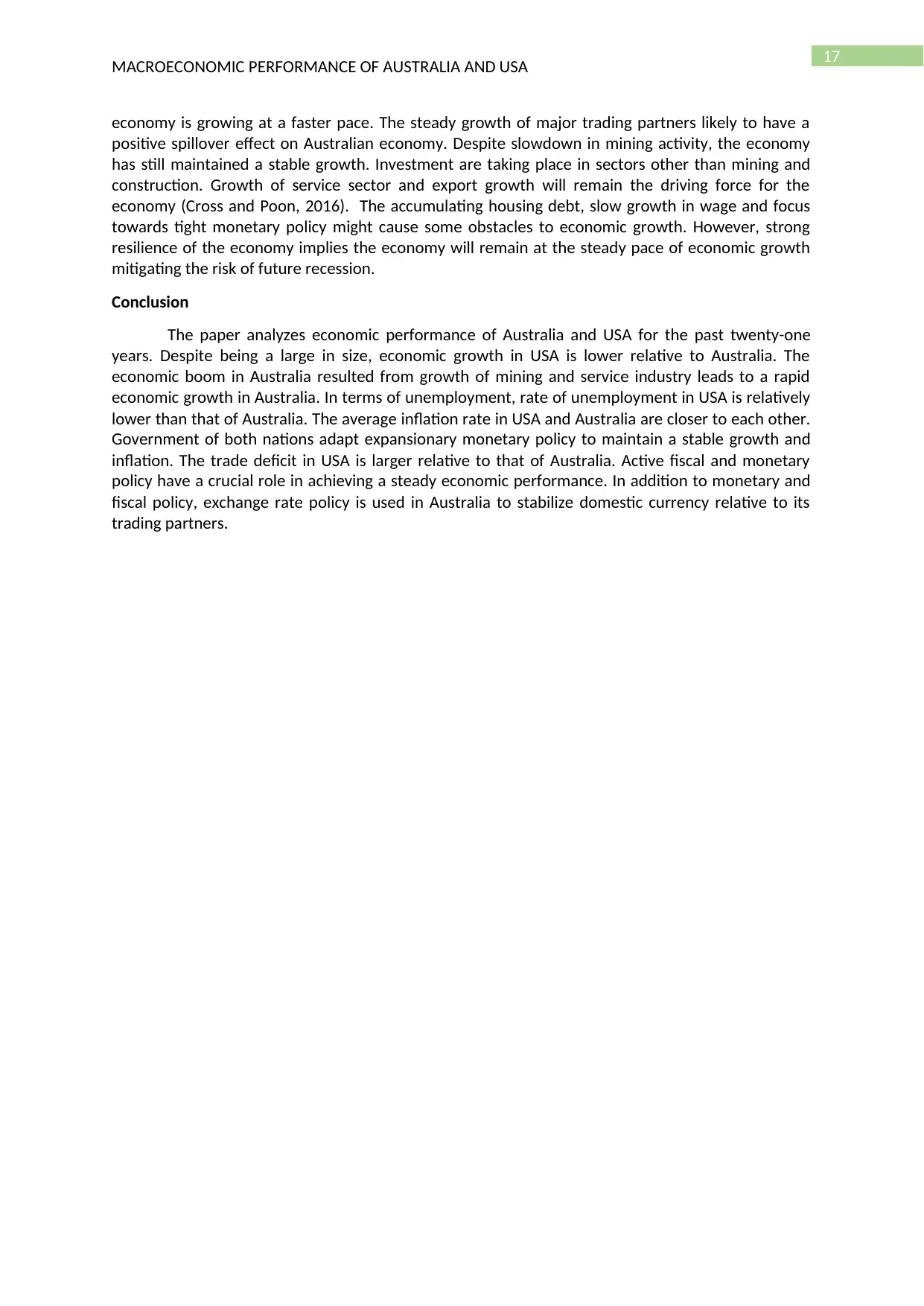
17
MACROECONOMIC PERFORMANCE OF AUSTRALIA AND USA
economy is growing at a faster pace. The steady growth of major trading partners likely to have a
positive spillover effect on Australian economy. Despite slowdown in mining activity, the economy
has still maintained a stable growth. Investment are taking place in sectors other than mining and
construction. Growth of service sector and export growth will remain the driving force for the
economy (Cross and Poon, 2016). The accumulating housing debt, slow growth in wage and focus
towards tight monetary policy might cause some obstacles to economic growth. However, strong
resilience of the economy implies the economy will remain at the steady pace of economic growth
mitigating the risk of future recession.
Conclusion
The paper analyzes economic performance of Australia and USA for the past twenty-one
years. Despite being a large in size, economic growth in USA is lower relative to Australia. The
economic boom in Australia resulted from growth of mining and service industry leads to a rapid
economic growth in Australia. In terms of unemployment, rate of unemployment in USA is relatively
lower than that of Australia. The average inflation rate in USA and Australia are closer to each other.
Government of both nations adapt expansionary monetary policy to maintain a stable growth and
inflation. The trade deficit in USA is larger relative to that of Australia. Active fiscal and monetary
policy have a crucial role in achieving a steady economic performance. In addition to monetary and
fiscal policy, exchange rate policy is used in Australia to stabilize domestic currency relative to its
trading partners.
MACROECONOMIC PERFORMANCE OF AUSTRALIA AND USA
economy is growing at a faster pace. The steady growth of major trading partners likely to have a
positive spillover effect on Australian economy. Despite slowdown in mining activity, the economy
has still maintained a stable growth. Investment are taking place in sectors other than mining and
construction. Growth of service sector and export growth will remain the driving force for the
economy (Cross and Poon, 2016). The accumulating housing debt, slow growth in wage and focus
towards tight monetary policy might cause some obstacles to economic growth. However, strong
resilience of the economy implies the economy will remain at the steady pace of economic growth
mitigating the risk of future recession.
Conclusion
The paper analyzes economic performance of Australia and USA for the past twenty-one
years. Despite being a large in size, economic growth in USA is lower relative to Australia. The
economic boom in Australia resulted from growth of mining and service industry leads to a rapid
economic growth in Australia. In terms of unemployment, rate of unemployment in USA is relatively
lower than that of Australia. The average inflation rate in USA and Australia are closer to each other.
Government of both nations adapt expansionary monetary policy to maintain a stable growth and
inflation. The trade deficit in USA is larger relative to that of Australia. Active fiscal and monetary
policy have a crucial role in achieving a steady economic performance. In addition to monetary and
fiscal policy, exchange rate policy is used in Australia to stabilize domestic currency relative to its
trading partners.

18
MACROECONOMIC PERFORMANCE OF AUSTRALIA AND USA
Reference list
Antonakakis, N., André, C. and Gupta, R., 2016. Dynamic spillovers in the United States: stock
market, housing, uncertainty, and the macroeconomy. Southern Economic Journal, 83(2), pp.609-
624.
Aph.gov.au, 2018. The Tools Of Macroeconomic Policy—A Short Primer – Parliament Of Australia.
[online] Aph.gov.au. Available at:
<https://www.aph.gov.au/About_Parliament/Parliamentary_Departments/Parliamentary_Library/
pubs/BriefingBook44p/MacroeconomicPolicy> [Accessed 18 January 2019].
Bahmani Oskooee, M. and Nayeri, M.M., 2018. Policy Uncertainty and the demand for money in‐
Australia: An asymmetry analysis. Australian Economic Papers, 57(4), pp.456-469.
Castelnuovo, E., Lim, G. and Robinson, T., 2016. Introduction to the Policy Forum: Macroeconomic
consequences of macroprudential policies. Australian Economic Review, 49(1), pp.77-82.
Cross, J. and Poon, A., 2016. Forecasting structural change and fat-tailed events in Australian
macroeconomic variables. Economic Modelling, 58, pp.34-51.
Data.worldbank.org, 2018. World Bank Open Data | Data. [online] Data.worldbank.org. Available at:
<https://data.worldbank.org/> [Accessed 18 January 2019].
Denny, L. and Churchill, B., 2016. Youth employment in Australia: A comparative analysis of labour
force participation by age group. Journal of Applied Youth Studies, 1(2), p.5.
Fred.stlouisfed.org, 2018. Effective Federal Funds Rate. [online] Fred.stlouisfed.org. Available at:
<https://fred.stlouisfed.org/series/FEDFUNDS> [Accessed 18 January 2019].
Goodwin, N., Harris, J.M., Nelson, J.A., Roach, B. and Torras, M., 2015. Macroeconomics in context.
Routledge.
Heijdra, B.J., 2017. Foundations of modern macroeconomics. Oxford university press.
Johnson, H.G., 2017. Macroeconomics and monetary theory. Routledge.
Lindenberger, D., Weiser, F., Winkler, T. and Kümmel, R., 2017. Economic Growth in the USA and
Germany 1960–2013: The Underestimated Role of Energy. BioPhysical Economics and Resource
Quality, 2(3), p.10.
Makin, A.J., Pearce, J. and Ratnasiri, S., 2019. The optimal size of government in Australia. Economic
Analysis and Policy, 62, pp.27-36.
Nielsen, R.W., 2017. Population and Economic Growth in Australia: 8,000 BC-AD 1700 Extended to
60,000 BC. Journal of Economic and Social Thought, 4(1), pp.41-54.
rba.gov.au, 2018. Cash Rate. [online] Reserve Bank of Australia. Available at:
<https://www.rba.gov.au/statistics/cash-rate> [Accessed 18 January 2019].
rba.gov.au, 2018. Historical Data | RBA. [online] Reserve Bank of Australia. Available at:
<https://www.rba.gov.au/statistics/historical-data.html#exchange-rates> [Accessed 18 January
2019].
Reifschneider, D., Wascher, W. and Wilcox, D., 2015. Aggregate supply in the United States: recent
developments and implications for the conduct of monetary policy. IMF Economic Review, 63(1),
pp.71-109.
Reinhart, C.M. and Rogoff, K.S., 2015. Financial and sovereign debt crises: Some lessons learned and
those forgotten. Journal of Banking and Financial Economics, (2 (4)), pp.5-17.
MACROECONOMIC PERFORMANCE OF AUSTRALIA AND USA
Reference list
Antonakakis, N., André, C. and Gupta, R., 2016. Dynamic spillovers in the United States: stock
market, housing, uncertainty, and the macroeconomy. Southern Economic Journal, 83(2), pp.609-
624.
Aph.gov.au, 2018. The Tools Of Macroeconomic Policy—A Short Primer – Parliament Of Australia.
[online] Aph.gov.au. Available at:
<https://www.aph.gov.au/About_Parliament/Parliamentary_Departments/Parliamentary_Library/
pubs/BriefingBook44p/MacroeconomicPolicy> [Accessed 18 January 2019].
Bahmani Oskooee, M. and Nayeri, M.M., 2018. Policy Uncertainty and the demand for money in‐
Australia: An asymmetry analysis. Australian Economic Papers, 57(4), pp.456-469.
Castelnuovo, E., Lim, G. and Robinson, T., 2016. Introduction to the Policy Forum: Macroeconomic
consequences of macroprudential policies. Australian Economic Review, 49(1), pp.77-82.
Cross, J. and Poon, A., 2016. Forecasting structural change and fat-tailed events in Australian
macroeconomic variables. Economic Modelling, 58, pp.34-51.
Data.worldbank.org, 2018. World Bank Open Data | Data. [online] Data.worldbank.org. Available at:
<https://data.worldbank.org/> [Accessed 18 January 2019].
Denny, L. and Churchill, B., 2016. Youth employment in Australia: A comparative analysis of labour
force participation by age group. Journal of Applied Youth Studies, 1(2), p.5.
Fred.stlouisfed.org, 2018. Effective Federal Funds Rate. [online] Fred.stlouisfed.org. Available at:
<https://fred.stlouisfed.org/series/FEDFUNDS> [Accessed 18 January 2019].
Goodwin, N., Harris, J.M., Nelson, J.A., Roach, B. and Torras, M., 2015. Macroeconomics in context.
Routledge.
Heijdra, B.J., 2017. Foundations of modern macroeconomics. Oxford university press.
Johnson, H.G., 2017. Macroeconomics and monetary theory. Routledge.
Lindenberger, D., Weiser, F., Winkler, T. and Kümmel, R., 2017. Economic Growth in the USA and
Germany 1960–2013: The Underestimated Role of Energy. BioPhysical Economics and Resource
Quality, 2(3), p.10.
Makin, A.J., Pearce, J. and Ratnasiri, S., 2019. The optimal size of government in Australia. Economic
Analysis and Policy, 62, pp.27-36.
Nielsen, R.W., 2017. Population and Economic Growth in Australia: 8,000 BC-AD 1700 Extended to
60,000 BC. Journal of Economic and Social Thought, 4(1), pp.41-54.
rba.gov.au, 2018. Cash Rate. [online] Reserve Bank of Australia. Available at:
<https://www.rba.gov.au/statistics/cash-rate> [Accessed 18 January 2019].
rba.gov.au, 2018. Historical Data | RBA. [online] Reserve Bank of Australia. Available at:
<https://www.rba.gov.au/statistics/historical-data.html#exchange-rates> [Accessed 18 January
2019].
Reifschneider, D., Wascher, W. and Wilcox, D., 2015. Aggregate supply in the United States: recent
developments and implications for the conduct of monetary policy. IMF Economic Review, 63(1),
pp.71-109.
Reinhart, C.M. and Rogoff, K.S., 2015. Financial and sovereign debt crises: Some lessons learned and
those forgotten. Journal of Banking and Financial Economics, (2 (4)), pp.5-17.
Paraphrase This Document
Need a fresh take? Get an instant paraphrase of this document with our AI Paraphraser
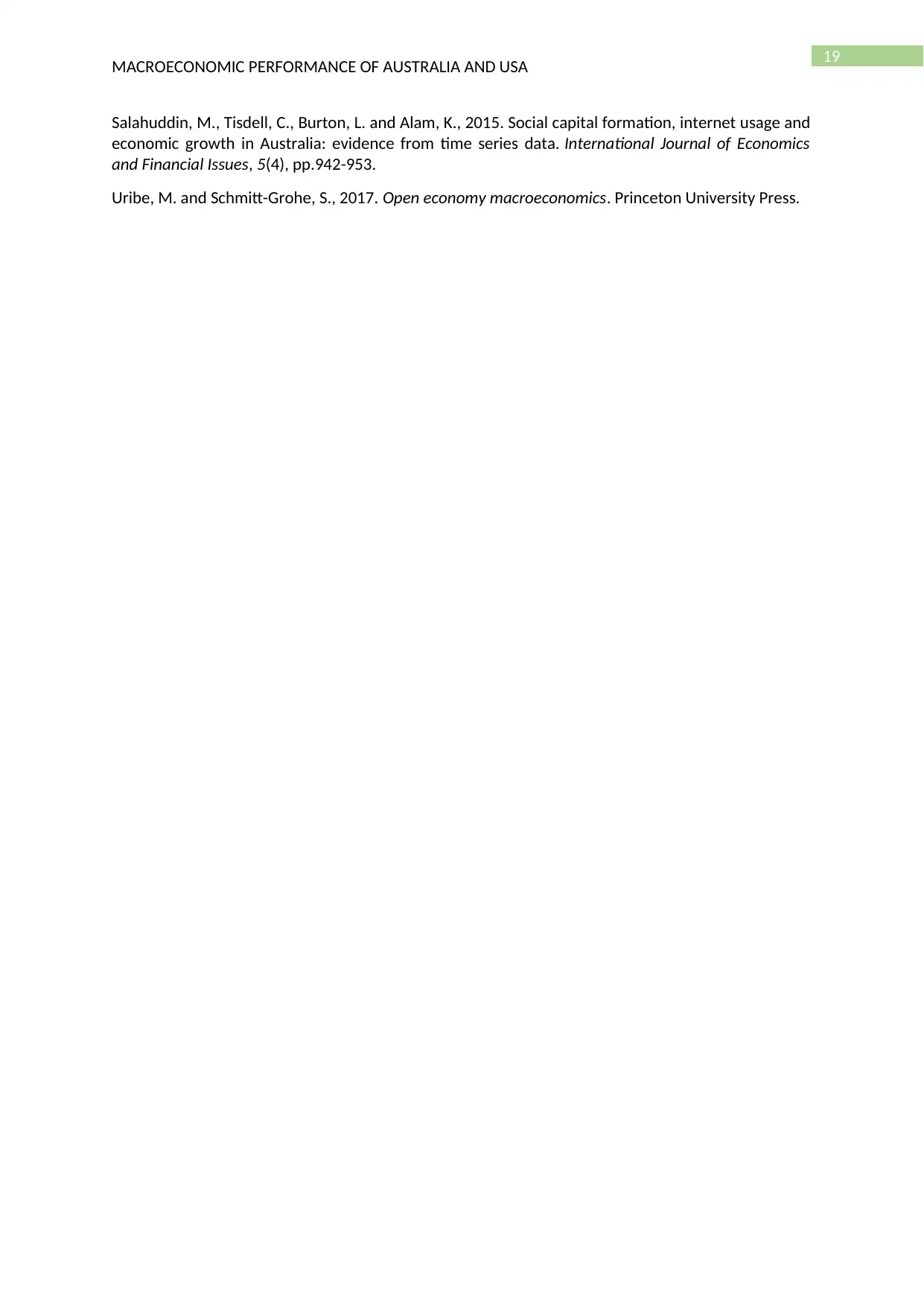
19
MACROECONOMIC PERFORMANCE OF AUSTRALIA AND USA
Salahuddin, M., Tisdell, C., Burton, L. and Alam, K., 2015. Social capital formation, internet usage and
economic growth in Australia: evidence from time series data. International Journal of Economics
and Financial Issues, 5(4), pp.942-953.
Uribe, M. and Schmitt-Grohe, S., 2017. Open economy macroeconomics. Princeton University Press.
MACROECONOMIC PERFORMANCE OF AUSTRALIA AND USA
Salahuddin, M., Tisdell, C., Burton, L. and Alam, K., 2015. Social capital formation, internet usage and
economic growth in Australia: evidence from time series data. International Journal of Economics
and Financial Issues, 5(4), pp.942-953.
Uribe, M. and Schmitt-Grohe, S., 2017. Open economy macroeconomics. Princeton University Press.
1 out of 20
Related Documents
Your All-in-One AI-Powered Toolkit for Academic Success.
+13062052269
info@desklib.com
Available 24*7 on WhatsApp / Email
![[object Object]](/_next/static/media/star-bottom.7253800d.svg)
Unlock your academic potential
© 2024 | Zucol Services PVT LTD | All rights reserved.





